感覚経験の人類学
Anthropology for Sensual Experience: an ethnography

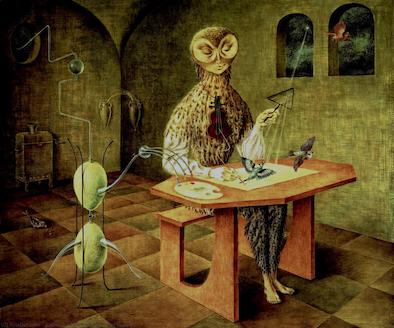

感覚経験の人類学
Anthropology for Sensual Experience: an ethnography



池田光穂
感覚経験の人類学とは、感覚/感性のエスノグラフィーの記述を試み、そこから得られるデータを比較検証し、感覚経験の経験主義的 理解を深める理論的貢献に挑戦する分野である。このページは、上掲(21K18363)の共同研究のうち、池田光穂の業績だけを報告する。したがって、その文責も池田にある。
感覚のエスノグラフィーとは、David Howes(2005)によるとセンススケープ (sensescape)の描写であり、それはArjun Appadurai(1996) の5つのスケープ(ethno-, media-, techno-, finance-, ideo-,)[2004:69] に加えたモダニティの第6のスケープと称されるものである。センススケープ (sensescape)は、感覚与件(Sense data)すなわち、エスノグラファーやインフォーマントが「感覚に与えられたもの (=センス・データ)」を通して、言語化されたものの資料体と、その分析から構成されるものである。
この研究は民族音楽学(音楽人類学)のSteven Feld, 視覚表象のOliver Sacks, メディアのMarshall McLuhan らによって先鞭がつけられ、民族誌記述におけるテイストの位置の復権(Paul Stroller)、記憶における Susan Stewart, シャーマンのフェミニニティにおけるSusan Stewart、料理における Lisa Law, 匂い経験の Jim Drobnick などの野心的な研究が続いている(authors を参照)。感覚の人類学の研究方法論は、文化人類学のフィール ドワークによるエスノグラフィー資料の収集である。感覚にまつわる社会現象の収集のために、参与観察の他に、Gopher等をつかった動態的映像記録、ナ ラティブ映像などを現場で再生して被調査者自身がメタ・コメンタリーをするなど、《感覚経験にまつわる内省》と《感覚経験の言語化》手法を動員することが 主 眼になる(→正式版の池田光穂「中米・カリブにおける感 覚のエスノグラフィーに関する実証研究」はこち ら)。
| ●なぜ感覚の人類学が重要なテーマになりえるのか? 1)感覚の人類学とは、人間の身体の文化人類 学的研究である。 2)身体の文化人類学には、さまざまな学問領域(医学、心理学、教育学、芸術学、哲学、そし て文化研究)からのアプローチが必要である。 3)ではなぜ、今、身体の文化人類学研究なのか?——それは人間の身体や五感(=おもに感覚経験を形づくるものと言われているもの)の普遍性ならびに斉一 性と、感覚を含む身体経験が文化の違いにより非常に多様な姿=現象を取りうることがわかっているからである。 4)したがって、人間の身体や五感(=おもに感覚経験を形づくるものと言われているもの)の普遍性ならびに斉一性を基準にして、感覚を含む身体経験の文化 的に多様な形態を記述する方法を開発する必要がある。 5)その方法を、感覚経験のエスノグラフィーを書く(writing ethnography of sensory experience)という形で表現してみよう 6)感覚の人類学研究とは、人間の身体の普遍性ならびに斉一性を基準にして、感覚を含む身体経験の文化的に多様な形態を、経験的に明らかにしてきた「人間 の身体に関する記述体( writing corps on human corps)」に関する文献的レヴューをおこなうことが、まず最初の作業になる。 7)次に、すでに存在している、感覚経験のエスノグラフィーの文献的渉猟と、いくつかの(手本になる)代表作を仔細に分析して、どのようにして、そのよう な感覚経験を記述することが可能になったのかについて考察する必要がある。 8)上掲の7)の作業と同時に、いくつかの方法論的モデル(手本)を、各人が精通する文化についての、先行研究調査や、新たに企画するエスノグラフィー調 査を通して、実験的に記述していくことが求められる。 9)このような作業を行う研究者・調査者が、共同研究会の機会をもったり、論文を作成し、それを相互に批判することで、感覚の人類学のスタイルを徐々に確 立することが可能になる(あるいはその緒に立つことが可能になる) 10)これらの議論を、読者は自家薬籠中のものにして、ようやく「感覚の人類学批判」に進むことができる。 ★感覚のエスノグラフィー:その方法論等の検討. |

「感覚経験の人類学」に関する理論的備忘
| ASC altered state
of consciousness |
変性意識状態とは、日常的な意識状態以外
の意識状態のこと。「1966にArnold M. Ludwigが提唱し、1969年発行のチャールズ・タート(Charles Tart)の著作
[2]を通じて一般に知られるようになった。Altered state of mindまたはaltered state of
awarenessともいう」 |
| サウンドスケープ
(soundscape) |
1960年代終わりに、カナダの作曲家マ
リー・シェーファー(Raymond
Murray Schafer, 1933-
)によって提唱された概念で「音風景」、「音景」などと訳される。風景には音が欠かせないという考え方で、そこからサウンドスケープデザインが生まれた。 |
| 感情の理論(W. ジェイムズ) Theory of emotion, by William James |
ジェー
ムズは、カール・ラングとは独立に1880年代に提唱した「感情のジェームズ・ラング説」の2人の提唱者のうちの1人である。この説では、感情とは何らか
の刺激によって生じる生理学的状態を心で知覚することであるとされる。ジェームズがよく引用する例では、私たちは熊を見、それを恐れて走るのではなく、熊
を見て走る。その結果、私たちは熊を恐れる。アドレナリンの分泌量や心拍数の上昇など、心で知覚したものが感情である。 James is one of the two namesakes of the James–Lange theory of emotion, which he formulated independently of Carl Lange in the 1880s. The theory holds that emotion is the mind's perception of physiological conditions that result from some stimulus. In James's oft-cited example, it is not that we see a bear, fear it, and run; we see a bear and run; consequently, we fear the bear. Our mind's perception of the higher adrenaline level, heartbeat, etc. is the emotion. (The Principles of Psychology.) |
| Media Studies,
Tronto University |
Institute of Communication, Culture,
Information and Technology. |
| 感覚経験の宗教学 |
感覚経験の宗教とは、感覚/感性のエスノ
グラ
フィーの記述を試み、そこから得られるデータを比較検証し、感覚経験の経験主義的理解を深める理論的貢献に挑戦する宗教研究の分野である。そのためには、
感覚のエスノグラフィーについての知識が有用である。感覚の宗教学の研究方法論は、文化人類学のフィール
ドワークによるエスノグラフィー資料の収集である。感覚にまつわる社会現象の収集のために、参与観察の他に、Gopher等をつかった動態的映像記録、ナ
ラティブ映像などを現場で再生して被調査者自身がメタコメンタリーをするなど、《感覚経験にまつわる内省》と《感覚経験の言語化》手法を動員することが主
眼になる。 |
| 民族音楽学 |
「音楽(music)とは、わたしたちが楽曲をすぐに想像するように、ある時間経過の中で進行す るメロディー、ハーモニー、リズム、そして音色の 要素から構成されます。 若年性の糖尿病により36歳で斃れるエリック・ドルフィーというサクソフォニストは、晩年のレコーディングアルバムのなかにある 「ミス・アン」という曲が終わった瞬間に、"When you hear music, after it's over, it's gone in the air. You can never capture it again."(君が音楽を聴き、それが終わったとき、虚空の彼方に消えてしまう。君はそれを二度とつかむことは決してできない)という声を残しています。 このような「儚い」音響的特性を研究するのが民族音楽学(ethnomusicology)なのです。しかしながら、虚空の彼方に消えてしまう音楽をどのよ う にして研究することができるのでしょうか?その手がかりは、文化人類学の方法に あります。すなわち後者は、研究対象になる人びとの生活に訪問し、彼/女らと同じ食事を し、言語を学び、インタビューをおこない、観察し、彼/女らのおこなっていることを記録する一連の方法からなります。インタビューの会話もまた対話が終 わった時に虚空の彼方に消えてしまうでしょう。しかし記憶と記録は残るのではないでしょうか。音楽も民族ごとにさまざまな様式の音楽が存在します。音楽やひいては人びとの〈音的経 験〉もまた、記譜の形で記録し、また身体記憶として呼び戻す(=それを演奏や再演といいます)ことが可能なのです。民族音楽学は、このように音楽を紡 ぎ出す人びと(=民族)の〈音的経験〉を、楽器の発展や変化の歴史や、そして語りや行動を記述することを通して明らかにします。この記録された書物や録音 を「音楽経験のエスノグラフィー(ethnography of musical experience)」と呼ぶことができるでしょう。民族音楽学(音楽人類学)者は、このような音のエスノグラフィーを編む文化人類学者のことなのです。音楽を通して2つの学問は融合するといっても過言でありません」(原文は池田による)。 |
| モーダリティ (modality) | モダリティ
(modality)とは、哲学では様相論理学の様相のこと。言語学では、言語表現のうちで「雨が降るかもしれない」というような可能性や蓋然性を表現する様相(モード)を有していることをさす。
言語学では、話している内容に対する話し手の判断や感じ方を表す言語表現のことをさす。「可能性が高い」「望ましい」「許される」などの意味を表す表現で
ある。英語の用法としては、"could"、"should"、"must "などの助動詞、"possibly"、"incuratively
"などの副詞、"conceivable"、"probable
"などの形容詞などが挙げられる。しかし、反事実、命題態度、証拠、習慣、ジェネリックなど、数え切れないほどの自然言語表現の意味に可能性や蓋然性など
が表現としてふくまれるので「モーダルな要素」がそこにあると考えるのである。 ウィキペディアの事例をひいてみよう。「対事モダリティには、「かもしれない」や「だろう」に見られるような可能性や蓋然性などに関わる認識様態のモダリ ティ(epistemic modality)と、「なければならない」や「てもよい」に見られる義務や許可などに関わる義務モダリティ(deontic modality)がある。認識様態モダリティと義務モダリティは言語によっては同じ形式で表現されることもある。例えば英語ではmust(に違いない/ なければならない)やmay(かもしれない/てもよい)が両意味に用いられる。日本語「なければならない」も文脈によっては義務でなく必然性を表現する」 |
| 倫理的判断 |
ジャッ
ク・ラカンによると《倫理とは不可能な欲望の充足行為 Ethics is the act of satisfying impossible
desires》と言うことができるかもしれない。倫理が欲望に根ざすものであるとすると、倫理を探究するものは、その欲望が何であるかを、常に意識しな
ければ、その解明は難しいだろう。 |
| 感覚の市場調査・感覚マーケティング(sensory
marketing) |
Sensory branding
is a type of marketing that appeals to all the senses in relation to
the brand. Wikipedia |
| 芸術経験 |
芸術の定義は、すべての芸術は存在を作り出すこと、現実的でも非現実でも、作品を通して現存を生じせしめる問題に関わるのである(アリストテレス)。 |
| 場所をつくる( place making) |
Gupta and Ferguson, |
| 空間認識 |
Massey, 2005. For Space. |
| 実践コミュニティ |
実践共同体あるいは実践コミュニティ(community of
practice)とは、参与者(参加者)が、ある集団への具体的な参加を通
して知識と技巧の修得が可能になる場のことである。また、そのような参加者の社会的実践がくりひろげられる場も総称して、実践共同体あるいは実践コミュニ
ティ(community of
practice)という。人びとは実践共同体において、さまざまな役割を担い行為することで、実践共同体を維持することに
貢献する。その際の学習とは、知能や技能を個人が習得することではなく(→学習の古典的定
義)、実践共同体への参加を通して得られる役割の変化や過程そのものである。徒弟制にもとづく伝統的職場、近代社会制度としての職場や学校などでみられ
る、集団への参与を通 して知識と技巧の修得が可能になる社会的実践がくりひろげられる場を実践共同体あるいは実践コミュニティ(community
of practica)という。ジーン・レイヴとエティエンヌ・ウェンガー(1993)による用語。 |
| 都市環境(urban setting) |
世界のグローバル・シティのなかで、人々が経験していることは、その環
境に共通点があるために、同じような経験をしているのか?それとも、個々のグローバル・シティに(先行する)固有の歴史的・文化的環境に依存して変化や多
様性がみられるのか? |
| 倫理的問題 |
検討すべき倫理・道徳的側面ついての課題;1)調査の倫理、2)過去の
事象に対するモラル的関与、3)普遍的倫理と局所的倫理、4)倫理的相対性と歴史 |
| 感覚性(sensoriality) |
Sarh Pink (2015:3)に登場する概念. |
| 実体性・有形性(corporeality) |
実体としての存在様式や様態(corporeal existence)(Pink 2015:16) |
| 応用研究(allied research) |
「応用」とは、集団的でかつ学問的な実用的関わりをさす。したがって、応用学者は、団体や組織(エージェント)に属し、またその職業倫理も、組織と開発対象への2つの領域(セクター)に対応するものとなるだろう。 |
| 具体化・エンボディメント(embodiment) |
抽象的な観念や実体概念に対して、実際に形が与えられること |
| 現象学 |
現象学、
とりわけ哲学的現象学(philosophical
phenomenology)は、主観的に生き、経験される客観性と現実(より一般的な)についての哲学的研究である。外界についての仮定を避けながら、
意識の普遍的な特徴を調査しようとするものであり、対象者に 現れる現象を記述し、生きた経験の意味と意義を探求することを目的としている。
このアプローチは、様々な科学分野、特に社会科学、人文科学、心理学、認知科学における質的研究において多くの応用を見出しているが、健康科学、建築学、
ヒューマンコンピュータインタラクションなどの多様な分野においても応用されている。これらの分野における現象学の応用は、行動に焦点を当てるのではな
く、主観的経験をより深く理解することを目的としている。 |
| 存在論と認識論 |
・存在論(オントロジー,
ontology)とは、存在自体のこと、在るとはどういうことかについて研究する学問。通常、哲学の一分野とみなされている。スタンフォード哲学エンサ
イクロペディアの「存在論的コミットメント」には、存在論とは、語源が示すように、「存在すること」、「存在するもの」について研究する学問である。存在
論者は問う:
どのような実体や種類の実体が存在するのか?人や水たまりや陽子といった具体的な実体のほかに、集合や数といった抽象的な実体は存在するのか。また、それ
らをインスタンス[=審級つまり審問のレベルを階層]化する特定の実体のほかに(あるいは代わりに)、性質や普遍は存在するのか。このような疑問は、時代
を超えて哲学者たちを分断してきた、とある。 ・エピステモロジー(Epistemology; 古代ギリシア語のἐπιστήμη (ἐπισE17↩τήμη) '知識'、および-logyから)は、知識に関する哲学の一分野である。認識論者は、知識の性質、起源、範囲、認識論的正当化、信念の合理性、および様々 な関連する問題を研究する。現代の認識論における議論は、一般的に以下の4つの核となる分野に集約されている。 (1)真理や正当化など、知識の性質や信念が知識を構成するために必要な条件についての哲学的分析; (2)知覚、理性、記憶、証言など、知識や正当化される信念の潜在的な情報源 (3)正当化された信念はすべて、正当化された基礎となる信念から導かれなけれ ばならないのか、それとも正当化には首尾一貫した信念の集合だけが必要なのかなど、 知識の体系や正当化された信念の構造、 (4)哲学的懐疑論は、知識の可能性を問うものであり、懐疑論は私たちの通常の知識主張に脅威を与えるのか、懐疑的な議論に反論することは可能なのか、と いった関連する問題である。 これらの議論やその他の議論において、認識論は「人は何を知っているのか」、「人が何かを知っているというのはどういうことか」、「正当化された信念は何 によって正当化されるのか」、「人は自分が知っていることをどうやって知るのか」といった問いに答えることを目的としている |
| 学習・学ぶこと(learning) |
さまざまな社会的活動に参与することを通して学ばれる知識と技能の習得実践のことを、状況的学習(situated learning)と
いう。外部表象化された〈知識や技能〉を学習者の内部に取り込む(=命題的知識の習得)というメタ
ファー(例:数式が頭に入った。ろくろを上手に回すことを覚えた)で、語ったり理解したりすることのできない学習——これを古典的学習という——への批判
あるいは乗り越えるために、人工知能研究者であるジー ン・レイブと人類学者エチエンヌ・ウェンガーの同名の書籍, "Situated
Learning"(1991)において主張された言葉である。これはウィリアム・ハンクス(による序文)が的確に示すように、学習の構
造が何であるかという考え方に対する根本的な革新に他ならない。「学習を命題的知識の獲得と定義する(→「古典的学習」)のではなく、レイブとウェンガー
は学習を特定のタイプの社会的共同的参加という状況の中におく。学習に
どのような認知過程と概念的構造が含まれるかを問うかわりに、彼らはどのような社会的関わり合いが学習の生起する適切な文脈を提供するのかを問う」(ハン
クス 1993:7) |
| 記憶(memory) |
感覚的記憶(sensory memory/memories):記憶と
は、データや情報が符号化され、保存され、必要に応じて取り出さ
れる心の機能である。それは、将来の行動に影響を与える目的で、時間をかけて情報を保持することである。過去の出来事を記憶できなければ、言語、人間関
係、あるいは個人のアイデンティティを発達させることは不可能である。[2] 記憶喪失は通常、物忘れや健忘症として説明される。 |
| エスノグラフィーの場所(ethnographic place) |
エスノグラフィーの場所(ethnographic place)(Pink 2015:48) |
| 予測不可能な世界(unpredictable world) |
予測不可能な世界が存在するので、エスノグラファーはフィールドにでか けて実証的な調査に従事する。 |
| 方法論 |
1)その方法論は君が知りたい情報/活動したい場に、ふさわしい場所
か、また、その方法論は君のやりたいことに有益に貢献するのか? 2)調査において使用するメディアは適切か? |
| 主観性と客観性 |
主観性と客観性:ある主張が、ある感覚を持つ存在の視点から考えたときにのみ真である場合、それは主観的に真である。 心とは無関係に確認できるものは客観的である。ある主張が、感覚を持つ存在の視点以外で考えても真実である場合、それは客観的に真実であるとされる。 |
| 間主観性 |
心
とは無関係に確認できるものは客観的である。ある主張が、感覚を持つ存在の視点以外で考えても真実である場合、それは客観的に真実であるとされる。科学
的客観性とは、偏見や偏見、外部からの影響を意図的に減らしながら科学を実践することである。道徳的客観性とは、道徳的または倫理的規範が、異なる対立す
る視点ではなく、一連の普遍的な事実または普遍的な視点を通じて互いに比較されるという概念である。えば、客観性は幻想であり、全く存在しないという特定
の思想家の見解や、主観性と客観性の間にグレーゾーンを含むスペクトルが存在するという見解、ある
いは20世紀以降に発展した間主観性の概念を通して他の心の問題を見るのが最善であるという見解などである。主観性と客観性の語源は、主観と客観であり、
それぞれ観察者と観察されるものを意味する哲学用語である。 |
| インタビュー |
(Pink 2015:73) |
| メディア |
メ
ディアはメッセージである(マーシャル・マクルーハン)。「ある所与の文化において、有意味なデータをアドレス指定して送り、記録保存し、処理す
ることを可能ならしめる諸技術と諸制度のネットワーク」キットラーのメディアの定義『書き取りシステム1800・1900』邦訳書解説(p.769) |
| 誘発(elicitation) |
(Pink 2015:88) |
| 「そこにいた」経験('being there'
experience) |
(Pink 2015:100) |
| 感覚的弟子としてのエスノグラファー |
(Pink 2015:103).エスノグラファーの経験の組織化 |
| メディアを媒介にする(mediated) |
(Pink 2015:117).感覚経験のテキスト化
(textualization of sensory
expericence)が可能になるから、感覚経験のエスノグラフィーは言語的なマテリアルとして成果物として世に問うことができるが、それは、文字
データのみならず、人びとの五感に働きかけるメディアを使って表現可能である。現地の料理や食事体験、栄養問題などを、「こちら側(being
here)」の人と共有するためには、現地食のレシピの公開のみならず、実際に現地食を作ってみて、感覚経験のテキストであるエスノグラフィーとあわせ
て、試食会や試飲会をすることで、経験を多層化することができる。 |
| 多元感覚研究(multusensory research) |
(Pink 2015:141). |
| 感覚的テキスト(sensory text) |
(Pink 2015:144).
感覚経験のテキスト化(textualization of sensory
expericence)が可能になるから、感覚経験のエスノグラフィーは言語的なマテリアルとして成果物として世に問うことができる。 |
| センススケープ (sensescape) | センススケープは、環境のなかでの行為者の感覚経験のことをさす。
Constance Classen and David Howes, "The
Museum as Sensescape: Western Sensibilities and Indigenous Artifacts"
を参照。 |
| 『判断力批判』 |
『判断力批判』はカントの三批判の最後の著作。判断力批判は第一部の美
的判断批判と、第二部の目的論的判断批判の2部に分かれる。 |
| 芸術人類学 |
芸術とは「作品や活動を通して、その存在意義や問題
(課題)をもたらすもの全てのこと」を言う(池田光穂)。したがって芸術はコミュニケーションのひとつである(「美的コミュニケーション」)。それゆえ、芸術を研究対象にする
人類学的研究を、芸術人類学という。 |
| ヤン・ムカジョ
フスキー |
ヤン・ムカジェフスキー(1891年11月11日 -
1975年2月8日)は、チェコの文学者、言語学者、美学者である。『チェコ構造美学論集 : 美的機能の芸術社会学』(→ヤン・ムカジョフスキーと美的機能) |
| ナディア・セレメタキス(C. Nadia Seremetakis) |
当
該論文は、コルポルタージュ(書籍の販売や行商)というメタファーを使って感覚とナラティブの経験が移動するという主張なので、セレメタキスは、ノスタル
ジーでもリアリズムではないと言っている(7ページの右のカラム、下から第二パラグラフ)。セレメタキスのコルポルタージュの概念はちょっと特異的な使い
方をしている。 C. Nadia Seremetakis. THE MEMORY OF THE SENSES:HISTORICAL PERCEPTION, CCMMENSAL EXCHANGE. Visual Anthropology Review. 9(2):2-19. 1993 |
| 創造的情動(émotion créatrice,
creative emotion) |
「創造的情動とは、知性における直観の発生である。人間が開かれた創造
的な全体性に到達す
るのは、したがって、観照することによってではなく、むしろ行動すること、創造することに
よってである。哲学そのものには、なお多くの観照が前提されている。〔哲学においては〕あたか
も知性はすでに情動に、したがって直観に浸食されていたかのようにすべてはなされるが、こ
の情動に即して創造をするには充分ではない。それゆえ、哲学者よりもより遠くへ向かう偉大
なる魂は、芸術家の魂や神秘家の魂なのである(少なくともベルクソンは、キリスト教の神秘
主義的信仰を、溢れかえる活動性そのもの、行為や創造として描いている)。極限的には、神
秘家こそがあらゆる創造を利用し、それが動的なものであればあるほど適切なその表現を発明
するのである。開かれた有限の神(それがエラン・ヴィタールの特徴である)に仕える神秘的
な魂は、全宇宙を能動的に活用し、そのなかにはみるべきものも観照すべきものも何もない全
体の開けを再生産する。すでに情動につき動かされている哲学者は、経験のなかで与えられた
混合物を分かちあう線を解き放った。そして哲学者は、「転回点」の向こう側にまでその痕跡
を延長させ、そのはるか遠くに、すべての線が再び出会う潜在的な点を指示していたので
あたかも、哲学的直観のなかで未規定のままにとどまっていたものが、神秘的直観のなかであ
らたな種類の規定をうけとるかのようであるー~あたかも、本来の意味で哲学的な「蓋然性」
が、神秘的な確実性へと延長されたかのようである。おそらく哲学者は、神秘的な魂を外部か
らしか、蓋然性という自らの線の観点からしか考察することができない。しかしまさしく、神
秘主義の存在そのものが、この最終的な確実性への変質に対して高次の蓋然性を与えるのであ
り、方法のあらゆる様相に対する外皮や極限のようなものを与えるのである」(ドゥルーズ『ベルクソニズム』2017:127-128)。 Elle [émotion créatrice] est la genèse de l'intuition dans l'intelligence. Si l'homme accède à la totalité créatrice ouverte, c'est donc en agissant, en créant plutôt qu'en contemplant. Dans la philosophie même, il y a encore trop de contemplation supposée: tout se passe comme si l'intelligence était déjà pénétrée d'émotion, donc d'intuition, mais non pas suffisamment pour créer conformément à cette émotion (1). Aussi les grandes âmes, plus loin que les philosophes, sont celles des artistes et des mystiques (du moins d'une mystique chrétienne que Bergson décrit comme étant tout entière activité surabondante, action, création) (2). A la limite, c'est le mystique qui joue de toute la création, qui en invente une expression d'autant plus adéquate qu'elle est dynamique. Servante d'un Dieu ouvert et fini (tels sont les caractères de l'Élan vital), l'âme mystique joue activement tout l'univers, et reproduit l'ouverture d'un Tout dans lequel il n'y a rien à voir ou à contempler. Déjà animé par l'émotion, le philosophe dégageait des lignes qui se partageaient les mixtes donnés dans l'expérience; et il en prolongeait le tracé jusqu'au-delà du « tournant », il indiquait dans le lointain le point virtuel où toutes se rencontraient. Tout se passe comme si ce qui restait ndéterminé dans l'intuition philosophique recevait une détermination d'un nouveau genre, dans l'intuition mystique - comme si la « probabilité » proprement philosophique se prolongeait en certitude mystique. Sans doute le philosophe ne peut-il considérer l'âme mystique que du dehors, et du point de vue de ses lignes de probabilité (1). Mais précisément, l'existence même du mysticisme donne une probabilité supérieure à cette transmutation finale en certitude, et comme une enveloppe ou une limite à tous les aspects de la méthode. (pp.118-119) |
| 身体化された認知(Embodied cognition) |
身体化された認知(認識)とは、認知が生物の身体の状態や能力によって
どのように形成されるかを調査する、多様な理論のグループを指す。身体化された要因
には、運動系、知覚系、環境との身体的な相互作用(状況依存性)、生物の脳と身体の機能構造を形成する世界についての想定などが含まれる。身体化された認
知は、これらの要素が、知覚バイアス、記憶想起、理解、高度な精神構造(意味の帰属やカテゴリーなど)、およびさまざまな認知タスク(推論や判断)のパ
フォーマンスなど、幅広い認知機能に不可欠であることを示唆している。
身体化された心理論は、認知主義、計算論、デカルト主義的二元論などの他の理論に異議を唱えている。[1][2]
拡張された心理論、状況的認知、非活性化説と密接に関連している。現代版は、心理学、言語学、認知科学、力学系、人工知能、ロボット工学、動物認知、植物
認知、神経生物学の最新の研究から得られた理解に基づいている。 |
| 情動的(アフェクト的)転回(Affective turn) |
1995年以降[15][16]、社会科学と人文科学の多くの研究者
が、表象の支配的パラダイム(修辞学と記号論に基づく)の外側に位置する経験領域(身
体的経験を含む)を理解する手段として情動理論を探求し始めた。この動きは情動的転回と呼ばれている。[17]
したがって、これらのアプローチは可能な限り多様な相互作用や遭遇に関心を持ち、それらは必ずしも人間の感性に限定されない。[18]
デリューズとガタリの『千の平原』の翻訳者であるカナダの政治哲学者ブライアン・マッスミは、情動に関する影響力のある定義(前述参照)を示し、文化的形
成や現実世界・仮想世界との相互作用における運動と感覚の軽視された重要性について論じている。[19]
同様に、地理学者ナイジェル・スリフトは、彼が「非表象理論」と呼ぶものにおけるアフェクトの役割を探求している。[20]
2010年にはメリッサ・グレッグとグレゴリー・J・セイワースによる『アフェクト理論読本』が出版され、アフェクト理論の著作を初めて網羅した。
[21] モグ・ステイプルトン、ダニエル・D・ハット、ピーター・キャルーサーズといった研究者たち[22]
[23][24]は、情動と感情の概念を調査・発展させる必要性を指摘している。彼らは、これらが認知科学における身体性の発展するパラダイム、意識研
究、心哲学において重要だと主張する。モグ・ステイプルトンは、認知科学が「真に身体化された」認知科学となるためには、このステップが不可欠だと述べて
いる(→「アフェクト」)。 |
☆
★五感・等についての覚書
| 感
覚 |
器
官 |
|
| 視覚 |
目 |
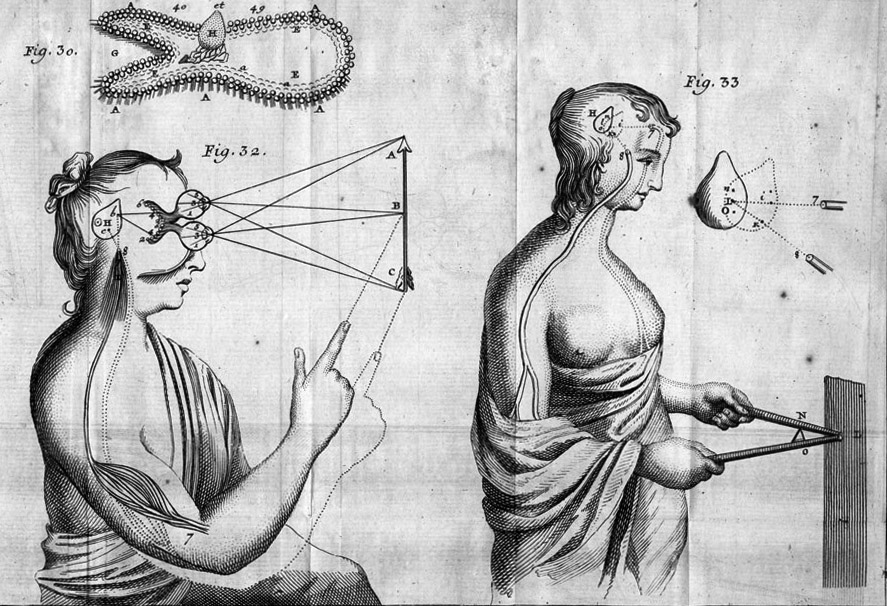 René Descartes (1596-1650): L’homme de René Descartes, et la formation du foetus…. Paris: Compagnie des Libraires, 1729. |
| 聴覚 |
耳 |
 His master's voice |
| 臭覚・匂い |
鼻 |
 The sense of smell. Bequest of Mrs E.G. Elgar, 1945 Museum of New Zealand Te Papa Tongarewa. |
| 味覚・味 |
舌 |
【味覚の病理から入る味覚経験の分析】
テレンバッハ『味と雰囲気』
は、記述的な病的体験論からやがて人間学的な基盤での研究にと進められ、エーディンガーの「口腔感覚」を内因精神病的変転の表現野として構成、「口腔感
覚」と「雰囲気的なもの」との人間学的な関連や、それらが分裂病やメランコリーや内因精神病でどういう障害となって現われるかを考察している。幻味、幻嗅
の問題、自己臭の問題への具体的な成果をふまえつつ、症例や芸術作品を通じて、新鮮な人間探求への角度を示している。▶1 口腔感覚の現象学(「口腔感
覚」という概念;口腔的識覚の精神病性変様に対する尺度の問題 ほか)▶2 味と雰囲気的なもの(味わうことと味覚との相互性;におうことと嗅ぐこと—雰
囲気的な発散と雰囲気的な勘 ほか)▶3 危機的変転の前触れとしての雰囲気的なものの変化(危機と変転を媒介する雰囲気的なもの;聖なるものの雰囲気と
サウロの改心 ほか)▶4 病理的口腔感覚体験における精神病的に変化した雰囲気(口腔識覚の体験世界における精神病的雰囲気の透明性;内因性メランコ
リーにおける病的な口腔感覚体験 ほか)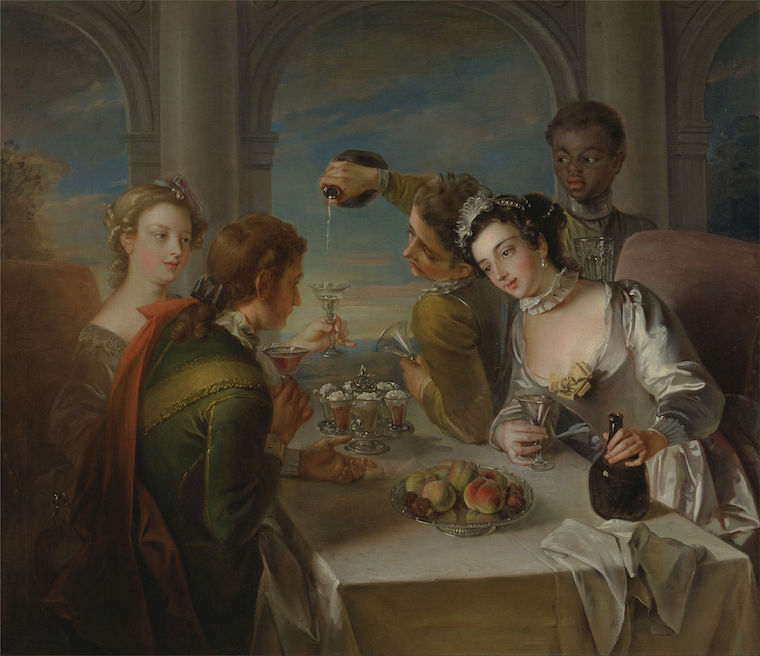 Philippe Mercier - The Sense of Taste |
| 触覚・手触り・肌感覚 |
皮膚 |
 El Tacto, cuadro de la serie de Los sentidos (Museo Norton Simon, Pasadena, Estados Unidos) por José de Ribera |
| 時間感覚 |
内奥 |
時間感覚はどのように感じ得るのか?(カルロス・フエンテス)(→
ニュートン力学が支配する時間では、時間は「可逆的プロセス」として考察される。他方、熱力学第二法則に従った時間においては「非可逆的プロセス」として
把握される。(出典:サイバネティクス) |
| カントの時間と空間概念 |
"Even a casual reader of Kant’s
Critique of Pure Reason (Kritik der reinen Vernunft, first published in
1781) will notice the prominence he gives to his discussion of space
and time. In tandem, scholars consider this discussion to be central to
Kant’s so-called critical philosophy. Given Kant’s reputation for
developing difficult, not to say obscure, philosophical views, it will
also not surprise the reader to learn that there is no consensus on how
Kant’s conception of space and time ought to be characterized and
explicated. So the goal of this entry is to bring some clarity to
Kant’s views by situating them historically and philosophically within
the milieu of some central debates concerning space and time in the
early modern period, especially the rich century between the first
edition of Newton’s Principia mathematica, which was first published in
1687, and the publication of the second edition of the Critique of Pure
Reason exactly a hundred years later. The difficulty of comprehending
Kant’s views gives interpreters a reason to place a special emphasis on
context—I will especially highlight Kant’s reactions to his most
significant predecessors in this area, Leibniz and Newton. The focus
throughout will be on Kant’s magnum opus, the Critique of Pure Reason.
Following tradition, and to some extent Kant’s own lead, the focus will
also be on space and on our representation of space, although parallel
points concerning time (and its representation) will sometimes be
indicated.# https://plato.stanford.edu/entries/kant-spacetime/ カントの『純粋理性批判』(Kritik der reinen Vernunft、初版は1781年)を何気なく読んだ人でも、彼が空間と時間についての議論を重要視していることに気づくだろう。同時に、学者たちはこ の議論がカントのいわゆる批判哲学の中心であると考えている。カントが難解な哲学的見解を展開することで知られていることから、カントの空間と時間に関す る概念をどのように特徴づけ、説明すべきかについてコンセンサスが得られていないことを知っても、読者は驚かないだろう。そこで本エントリーの目的は、近 世における空間と時間に関するいくつかの中心的な議論、特に1687年に出版されたニュートンの『プリンキピア数学』の初版から、そのちょうど100年後 に『純粋理性批判』の第2版が出版されるまでの豊かな1世紀の間に、カントの見解を歴史的・哲学的に位置づけることによって、カントの見解をある程度明確 にすることである。カントの見解を理解することが難しいからこそ、解釈者は文脈を特に重視するのである。私は特に、この分野における最も重要な先達であるライプニッツとニュートンに対するカントの反応に焦点を当てる。全体を通して、 カントの大著である『純粋理性批判』に焦点を当てる。伝統に従い、ま たある程度はカント自身の導きもあって、焦点は空間と空間の表現にも当てられるが、時間(とその表現)についても並行して指摘されることがある。 |
★雑多なリンク集
++
リンク
Empire of the senses : sensory practices of colonialism in early America, edited by Daniela Hacke, Paul Musselwhite, (Early American history series : the American colonies, 1500-1830 / edited by Jaap Jacobs, L. H. Roper, Bertrand Van Ruymbeke, v. 8)Brill, c2018
書誌情報( "Nielsen BookData");
"Empire of the Senses brings together pathbreaking scholarship on the
role the five senses played in early America. With perspectives from
across the hemisphere, exploring individual senses and multi-sensory
frameworks, the volume explores how sensory perception helped frame
cultural encounters, colonial knowledge, and political relationships.
From early French interpretations of intercultural touch, to English
plans to restructure the scent of Jamaica, these essays elucidate
different ways the expansion of rival European empires across the
Americas involved a vast interconnected range of sensory experiences
and practices. Empire of the Senses offers a new comparative
perspective on the way European imperialism was constructed, operated,
implemented and, sometimes, counteracted by rich and complex new
sensory frameworks in the diverse contexts of early America. This book
has been listed on the Books of Note section on the website of Sensory
Studies, which is dedicated to highlighting the top books in sensory
studies: www.sensorystudies.org/books-of-note"
| Introduction :
making sense of
colonial encounters and new worlds / Daniela Hacke and Paul Musselwhite |
|
| Touching on communication :
visual and textual representations of touch as friendship in early
colonial encounters / Céline Carayon |
|
| Mission soundscapes : demons,
Jesuits, and sounds in Antonio Ruiz de Montoya's Conquista espiritual
(1639) / Jutta Toelle |
|
| Singing with strangers in early
seventeenth-century New France / Michaela Ann Cameron |
|
| The pain of senses escaping :
eighteenth-century Europeans and the sensory challenges of the
Caribbean / Annika Raapke |
|
| Color visions : perceiving
nature in the Portuguese Atlantic world / Marília dos Santos Lopes |
|
| Colonial sensescapes : Thomas
Harriot and the production of knowledge / Daniela Hacke |
|
| Merian and the pineapple :
visual representation of the senses / Megan Baumhammer and Claire
Kennedy |
|
| "Delightful a fragrance" :
native American olfactory aesthetics within the eighteenth-century
Anglo-American botanical community / Andrew Kettler |
|
| The aromas of flora's wide
domains : cultivating gardens, aromas, and political subjects in the
late seventeenth-century English Atlantic / Kate Mulry |
|
| Exploring underwater worlds :
diving in the late seventeenth-/early eighteenth-century British Empire
/ Rebekka von Mallinckrodt |
Empire of the senses : the sensual culture reader / edited by David Howes, New York : Berg , 2005
書誌情報("Nielsen
BookData");"With groundbreaking contributions by Marshall McLuhan,
Oliver Sacks, Italo Calvino and Alain Corbin, among others, Empire of
the Senses overturns linguistic and textual models of interpretation
and places sensory experience at the forefront of cultural analysis.
The senses are gateways of knowledge, instruments of power, sources of
pleasure and pain - and they are subject to dramatically different
constructions in different societies and periods. Empire of the Senses
charts the new terrains opened up by the sensual revolution in
scholarship, as it takes the reader into the sensory worlds of the
medieval witch and the postmodern mall, a Japanese tea ceremony and a
Boston shelter for the homeless. This compelling revisioning of history
and cultural studies sparkles with wit and insight and is destined to
become a landmark in the field."
| General
Introduction: Empires of the Senses |
0. Empires of the Senses |
| Part I: The
Prescience of the Senses 'Culture Tunes Our Neurons' |
1. 'The Mind's
Eye: What the Blind See'--Oliver Sacks * |
| 2. 'Inside the
Five Sense Sensorium'--Marshall McLuhan |
|
| Part II. The
Shifting Sensorium Historicizing Perception |
3. 'Remembering
the Senses'--Susan Stewar |
| 4. The Witch's
Senses: Sensory Ideologies and Transgressive Femininities from the
Renaissance to Modernity'--Constance Classen |
|
| 5. 'The
Senses Divided: Organs, Objects, and Media in Early Modern
England'--Carla Mazzio |
|
| 6. 'The
Death of the Sensuous Chemist: The 'New' Chemistry and the
Transformation of Sensuous Technology'--Lissa Roberts |
|
| 7. 'Charting the
Cultural History of the Senses'-- Alain Corbin |
|
| Part III.
Sensescapes Sensation in Cultural Context |
8. McLuhan in the
Rainforest: The Sensory Worlds of Oral Cultures'--Constance Classen |
| 9. Consciousness
as 'Feeling in the Body': A West African Theory of Embodiment, Emotion
and the Making of Mind'--Kathryn Linn Geurts |
|
| 10. Places
Sensed, Senses Placed: Towards a Sensuous Epistemology of
Space'--Steven Feld |
|
| 11. The Tea Ceremony: A Symbolic
Analysis'--Dorinne Kondo |
|
| 12. 'Engaging the Spirits of
Modernity: Temiar Songs of a Changing World'--Marina Roseman |
|
| 13. Home Cooking: Filipino Women and
Geographies of the Senses in Hong Kong'--Lisa Law |
|
| Part IV. The Aestheticization of
Everyday Life Aestheticization Takes Command |
14. 'A Tonic of Wildness:
Sensuousness in Henry David Thoreau'--Victor Carl Friesen |
| 15 Volatile Effects: Olfactory
Dimensions of Art and Architecture'--Jim Drobnick |
|
| 16. HYPERAESTHESIA, or, The
Sensual Logic of Late Capitalism'--David Howes |
|
| 17. Under the Jaguar Sun'--Italo
Calvino |
|
| 18. Michel Serres' Five
Senses'--Steven Connor |
|
| 19. Darwin's Disgust'--William
Ian Miller |
|
| Part V. The Derangement of the
Senses The Senses Disordered |
20. Strindberg's 'Deranged
Sensations''--Hans-Goeran Ekman |
| 21. Movement, Stillness: On the
Sensory World of a Shelter for the 'Homeless Mentally Ill''--Robert
Desjarlais |
|
| 22. 'Dystoposthesia: Emplacing
Environmental Sensitivities'--Christopher Fletcher |
|
| Sensory
Bibliography |
●David Howes教授
| Anthropology of the
Senses. How are our senses formed by culture? What is the world like to societies that emphasize touch or hearing rather than sight? This research explores the life of the senses in society. To a greater or lesser extent, every domain of sensory experience, from the sight of an artwork to the scent of perfume to the savour of dinner, is a field of cultural elaboration. Hence the necessity of adopting an anthropological approach to the study of the sensorium. Sensory experience may be structured and invested with meaning in many different ways across cultures, as I have learned from field research in the interior and coastal regions of Papua New Guinea, the Andean region of Argentina, the American southwest, and the Pitt Rivers Musem in Oxford. https://www.david-howes.com/DH-research.htm |
感覚の人類学 私たちの感覚は文化によってどのように形成されているのでしょうか。視覚よりも触覚や聴覚を重視する社会にとって、世界はどのようなものなのだろうか。 この研究は、社会における感覚の営みを探るものである。美術品の視覚、香水の香り、夕食の味わいなど、あらゆる感覚体験の領域は、多かれ少なかれ、文化の 精緻化の場である。それゆえ、感受性の研究に人類学的なアプローチを採用する必要がある。 私は、パプアニューギニアの内陸部と沿岸部、アルゼンチンのアンデス地方、アメリカ南西部、オックスフォードのピットリバーズ美術館での現地調査から、感 覚体験は文化によってさまざまに構成され、意味づけされていることを学んだ。 |
| Sensory Studies Series, David
Howes (Series Editor) As the leading publisher of scholarship on the culture of the senses, Bloomsbury present this series of cutting-edge case studies, syntheses and translations in the emergent field of sensory studies. Building on the success of the Sensory Formations series, this series, edited by David Howes, provides an invaluable resource for those involved in research or teaching courses on the senses as object of study and/or means of inquiry. Embracing the insights of a wide array of humanities and social science disciplines, the field of sensory studies has emerged as the most comprehensive and dynamic framework yet for making sense of human experience. This series offers something for every disciplinary taste and sensory inclination. |
センサリー スタディーズ シリーズ、デイヴィッド・ハウズ
(シリーズエディター) 感覚文化研究の第一人者であるブルームズベリー社が、新たな分野である感覚研究の最先端のケーススタディ、統合、翻訳を紹介するシリーズです。デービッ ド・ハウズが編集した本シリーズは、「センサリー・フォーメーション」シリーズの成功に基づき、研究対象として、あるいは探求の手段として、感覚に関する 研究や講義に携わる人々にとって貴重なリソースを提供する。人文・社会科学の幅広い分野の知見を取り入れた感覚研究の分野は、人間の経験を理解するための 最も包括的でダイナミックな枠組みとして登場する。本シリーズは、あらゆる学問分野と官能的な志向に対応することができる。 |
| Mediations
of Sensation: Sensory Anthropology and the Creation/Evaluation of
Multimodal Interactive Environments. (2010-2013) Team Members Principal Investigator Chris Salter, Design and Computation Arts, Concordia University Co-Researchers David Howes, Sociology and Anthropology, Concordia University |
|
| Brief Project Description Mediations of Sensation is a research-creation program bringing together artistic work in “multimodal” (many senses) environments using new technologies with anthropological research into the varieties of human sense experience across cultures. The main objective is to explore techniques of the senses found in non-Western cultural contexts and use these as creative, cross-cultural frameworks to inform the design and evaluation of user experience in sensorially compelling immersive environments with new digital media. The artistic design, development and ethnographic evaluation of the project components will be informed by interdisciplinary collaboration with Concordia anthropologist Dr. David Howes, an internationally recognized expert in the emergent field of sensory anthropology and director of the Concordia Sensoria Research Team (CONSERT). Artistically, Mediations of Sensation will produce a physically enclosed, portable architectural chamber that houses a single visitor for a specific duration of time. This chamber will play with a wide range of sensory phenomena specifically bordering on the just noticeable difference or threshold of human sense perception including sound, smell, sight, taste, touch, temperature, pressure and various kinesthetic (bodily) sensations such as proprioception (the sense of the relative position of the neighboring parts of one’s own body), balance and locomotion. Electronic sensor technologies that monitor body movement, temperature, humidity, sound and light levels in the chamber will continually modulate the intensity of extraordinarily low levels of sensory phenomena between the visitor and the chamber’s environment. These “threshold” levels of sensation will thus seek to merge the visitors’ sense of vision, hearing, touch, smell and space in diverse combinations, creating a powerful, immersive experience that transforms the sensory experience of body and self. In order to inform the architectural and sensory programming of the chamber, as well as the evaluation of visitor experience in the chamber, this project will draw on ethnographic techniques in sensory anthropology. Sensory anthropology is dedicated to charting the varieties of sensory experience across cultures through in-depth investigation of the distinctive ways in which the senses are socialized in different cultural settings. Every culture has its own modes of distinguishing and combining the senses. These “ways of sensing” give shape to the normative patterns of experience in that culture. A typology of differing sensory formations has been developed by members of the CONSERT team over the past two decades. This research database will be extended and refined in the course of this project, as well as mined for models that can serve as templates for the modulation of sensation in the chamber. Following their experience of the chamber, visitors will in turn be interviewed by the anthropological members of the team to explore the intersensory, intercultural ground of sense experience itself. The project cuts to the heart of research-creation by bringing together the embodied practices of artistic production with research techniques and methodologies from the social sciences for both creation and evaluation. Outcomes will include: (1) the series of installations that will be shown in both international fine and performing arts venues as well as technological and social science/humanities-based research contexts, (2) submission of journal articles conference papers and publications between the areas of media art, perception, science studies and anthropology (sensory studies), (3) ethnographic heuristics that benefit both the development of new sensory-activated immersive environments and anthropologists examining the senses, and (4) workshops with graduate and undergraduate students that interweave sensory ethnography, anthropology, architecture and the digital arts. Objectives/Questions of Research/Creation Mediations of Sensation will: Expand the possibilities of sensory knowledge experience in the growing discipline and practice of the new media arts. Create a dialogue between sensory anthropology, neuropsychology and artistic research-creation. Directly inform the sensory design of new technological environments through sensory knowledge that derives from non-Western cultural perspectives on the senses and goes beyond the conventional Western five senses model. Enable research into multi-modal, interactive environments with humanities/social science-based research rather than strictly engineering-based, technology research as is the usual case with new media art projects. Expose future new media artists/technologists to the research methods of the social sciences – particularly ethnographic methods – and anthropologists to the practices of new media artists working with sensory phenomena. Bring artists and anthropologists together inside the context of the artistic studio-lab setting to explore new settings for embodied knowledge production through the senses. Research and develop qualitative methods for how to understand and evaluate user experience in complex, multi-sensory environments that is not based on psychological measurements but direct first person experience. Train a new generation of artist researchers to negotiate between theory and practice, emerging new art forms and emerging social science paradigms like the anthropology of the senses. Acknowledgments The Mediations of Sensation project is funded by a grant from the Fonds Quebecois de Recherche en Science et Cultures.. |
プロジェクト概要 Mediations of Sensationは、新技術を用いた「マルチモーダル」(多くの感覚)環境における芸術作品と、文化間の人間の感覚体験の多様性に関する人類学的研究を 結びつける研究創造プログラムである。主な目的は、非西洋文化の文脈で見られる感覚のテクニックを探求し、新しいデジタルメディアを用いた感覚的に魅力的 な没入型環境のユーザー体験の設計と評価に情報を提供するための創造的で文化横断的なフレームワークとして、これらを使用することである。 プロジェクトの構成要素の芸術的デザイン、開発、民族誌的評価は、感覚人類学という新しい分野の国際的な専門家であり、コンコーディア・センソリア研究 チーム(CONSERT)のディレクターであるコンコーディア人類学者David Howes博士との学際的コラボレーションによってもたらされる。 Mediations of Sensationは、物理的に密閉された、持ち運び可能な建築的な部屋を制作し、特定の時間、一人の訪問者を収容する予定である。この部屋は、音、匂 い、視覚、味覚、触覚、温度、圧力、そしてプロプリオセプション(自分の身体の隣接する部分の相対的位置の感覚)、バランス、ロコモーションなどの様々な 運動感覚(身体的感覚)など、人間の感覚知覚のちょうど顕著な違いや閾値を境にして、幅広い感覚現象に浮遊する。体動、温度、湿度、音、光のレベルをモニ ターする電子センサー技術により、来場者とチャンバー内の環境との間の極めて低いレベルの感覚現象の強さを継続的に調整する。この「閾値」レベルの感覚 は、視覚、聴覚、触覚、嗅覚、空間感覚を多様な組み合わせで融合させ、身体と自己の感覚を変容させる強力な没入体験となる。 このプロジェクトでは、チャンバーの建築と感覚のプログラミング、そしてチャンバーでの来場者の体験を評価するために、感覚人類学のエスノグラフィーの技 術を活用する。感覚人類学は、異なる文化環境において感覚が社会化される独特の方法を徹底的に調査し、文化間の感覚体験の多様性を明らかにすることを目的 としている。どの文化にも、感覚を区別し、組み合わせるための独自の様式がある。これらの「感じ方」は、その文化における経験の規範的なパターンを形づく るものである。異なる感覚の形成に関する類型論は、過去 20 年間に渡って CONSERT チームのメンバーによって開発されてきた。この研究データベースは、このプロジェクトの過程で拡張・改良され、また、チャンバー内の感覚を調節するための テンプレートとして機能するモデルが掘り起こされる予定である。また、チャンバーでの体験の後、訪問者は人類学チームのメンバーからインタビューを受け、 感覚的、文化的に異なる感覚体験の基盤を探ることになる。 このプロジェクトは、創造と評価の両面において、芸術制作の身体的実践と社会科学の研究技術や方法論を融合させることで、研究創造の核心に迫るものであ る。その成果は以下の通りである。(1) 一連のインスタレーションは、国際的な美術・舞台芸術の場だけでなく、技術や社会科学・人文科学に基づく研究の場でも展示される予定である。(3)新しい 感覚を刺激する没入型環境の開発と感覚を研究する人類学者の双方に有益な民族誌的発見、(4)感覚民族誌、人類学、建築、デジタルアートを織り込んだ大学 院生・学部生とのワークショップ。 研究・創作の目的・問題点 感覚のメディエーションは ニューメディアアートの分野とその実践において、感覚的な知識体験の可能性を広げる。 感覚人類学、神経心理学と芸術的研究創造の間のダイアログを作成する。 従来の西洋の五感モデルを超えて、非西洋文化圏の感覚観に由来する感覚的知識を通じて、新しいテクノロジー環境の感覚的デザインに直接的に情報を提供す る。 ニューメディアアートプロジェクトにありがちな工学的な技術研究ではなく、人文・社会科学的な研究によって、マルチモーダルなインタラクティブ環境の研究 を可能にする。 将来のニューメディアアーティスト/テクノロジストに社会科学の研究手法(特にエスノグラフィーの手法)を、人類学者に感覚的な現象を扱うニューメディア アーティストの実践を紹介する。 アーティストと人類学者を芸術的なスタジオ・ラボの文脈の中で結びつけ、感覚を通して体現された知識生産のための新しい設定を探求する。 複雑な多感覚環境におけるユーザー体験を、心理学的な測定ではなく、直接体験に基づいて理解・評価するための定性的な方法を研究・開発する。 理論と実践、新しい芸術形態、感覚の人類学のような新しい社会科学のパラダイムの間で交渉する新しい世代のアーティスト研究者を育成する。 謝辞 Mediations of Sensationプロジェクトは、ケベック科学文化研究財団の助成を受けて実施されている。 |
The Museum of the Senses: Experiencing Art and Collections by Constance Classen, Durham: Bloomsbury. 2017
Traditionally sight has been the only sense with a ticket to enter the museum. The same is true of histories of art, in which artworks are often presented as purely visual objects. In The Museum of the Senses Constance Classen offers a new way of approaching the history of art through the senses, revealing how people used to handle, smell and even taste collection pieces. Topics range from the tactile power of relics to the sensuous allure of cabinets of curiosities, and from the feel of a Rembrandt to the scent of Monet's garden. The book concludes with a discussion of how contemporary museums are stimulating the senses through interactive and multimedia displays. Classen, a leading authority on the cultural history of the senses, has produced a fascinating study of sensual and emotional responses to artefacts from the middle ages to the present. The Museum of the Senses is an important read for anyone interested in the history of art as well as for students and researchers in cultural studies and museum studies.
従来、美術館に入場するためのチケットは、視覚だけ
が使われてきた。美術史も同様で、美術品は純粋に視覚的な対象として提示されることが多い。コンスタンス・クラッセンは『五感の美術館』で、五感を通して
美術史にアプローチする新しい方法を提案し、かつて人々がコレクション作品をどのように扱い、匂いをかぎ、味わっていたかを解き明かす。遺物の触感から珍
品棚の官能的な魅力、レンブラントの手触りからモネの庭の香りまで、さまざまな話題を取り上げる。本書の最後には、現代の美術館がインタラクティブな展示
やマルチメディアを駆使していかに五感を刺激しているかを論じる。感覚文化史の第一人者であるクラッセンは、中世から現代に至るまで、芸術品に対する感覚
的・感情的な反応について魅力的な研究を展開しています。本書は、美術史に興味のある人はもちろん、カルチュラル・スタディーズやミュージアム・スタ
ディーズの学生や研究者にとっても重要な一冊である。
★グアテマラのマリンバ楽団
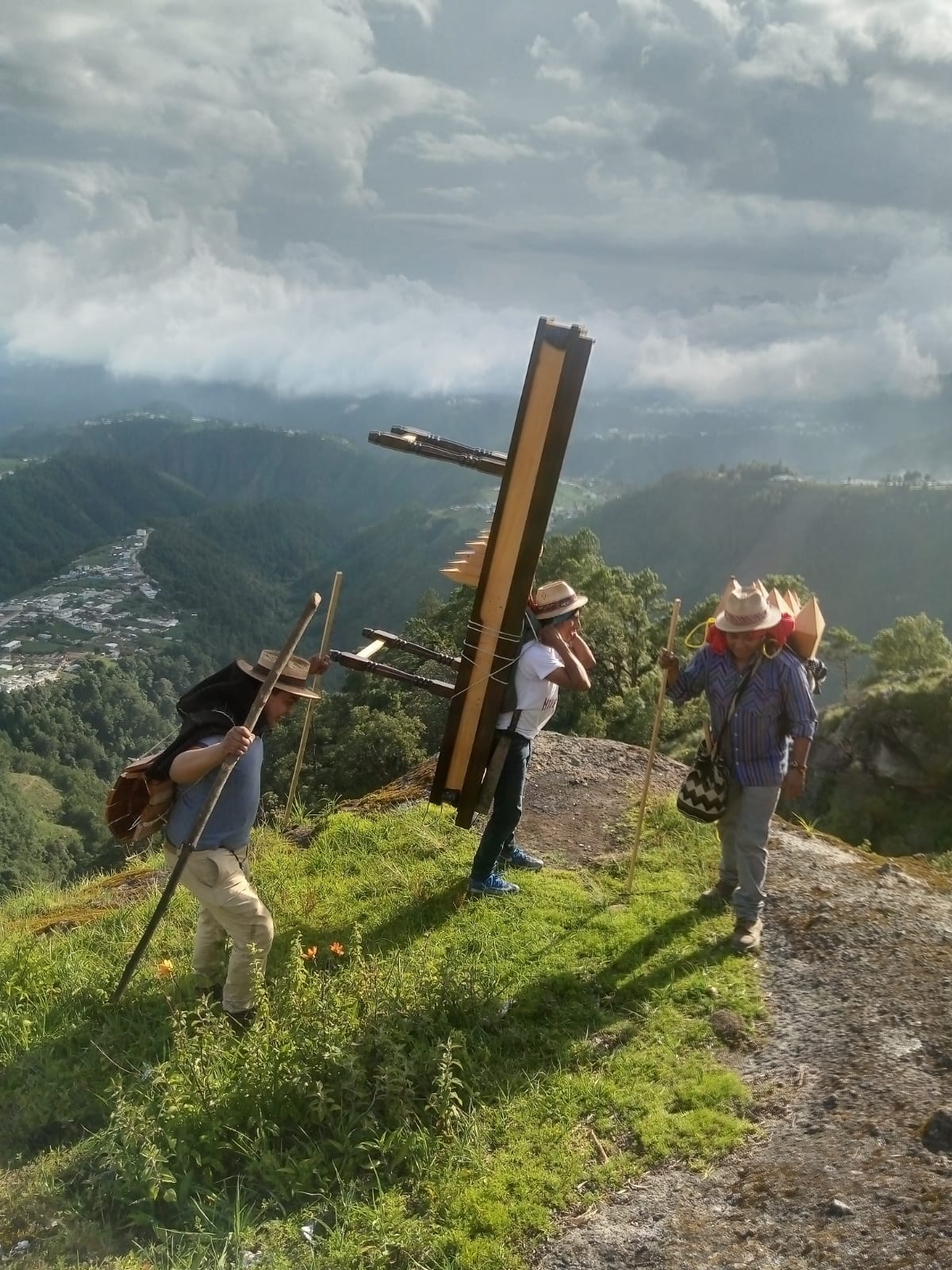
Miré admiré traté de
comprender creo que en buena parte he comprendido y es estupendo todo
es estupendo sólo allá lejos puede uno saberlo y es una linda vacación
es un rapto de imágenes es alegre.por Kayel Mekel.
Sound and sentiment : birds, weeping, poetics, and song in Kaluli expression, by Feld, Steven, Durham: Duke University Press, 3rd. 2012
書誌情報:"This thirtieth anniversary edition of Sound and Sentiment makes Steven Feld's landmark, field-defining book available to a new generation of scholars and students. A sensory ethnography set in the rain forest of Papua New Guinea, among the Kaluli people of Bosavi, Sound and Sentiment introduced the anthropology of sound, or the cultural study of sound. After it was first published in 1982, a second edition, incorporating additional field research and a new postscript, was released in 1990. The third edition includes all of the material from the first two editions, along with a substantial new introduction in which Feld discusses Bosavi's recent history and reflects on the challenges it poses for contemporary theory and representation." - Nielsen BookData.
「この『音と感傷』30周年記念版は、スティーブ
ン・フェルドの画期的な、この分野を定義する本を、新しい世代の学者や学生に提供するものである。パプアニューギニアの熱帯雨林、ボサビのカルリ族を舞台
にした感覚民族誌『音と感情』は、音の人類学、すなわち音の文化研究を紹介した。1982年に初版が出版された後、1990年に現地調査の追加とあとがき
を加えた第2版が出版された。第3版では、第1版と第2版のすべての内容に加えて、フェルドがボサヴィの最近の歴史について論じ、現代の理論と表現に突き
つけられた課題について考察した、大幅に新しい序文が加えられている。」
Pink, Sarah, Doing sensory ethnography. 2nd eds., SAGE, 2015.
"This bold agenda-setting title continues to spearhead interdisciplinary, multisensory research into experience, knowledge and practice. Drawing on an explosion of new, cutting edge research Sarah Pink uses real world examples to bring this innovative area of study to life. She encourages us to challenge, revise and rethink core components of ethnography including interviews, participant observation and doing research in a digital world. The book provides an important framework for thinking about sensory ethnography stressing the numerous ways that smell, taste, touch and vision can be interconnected and interrelated within research. Bursting with practical advice on how to effectively conduct and share sensory ethnography this is an important, original book, relevant to all branches of social sciences and humanities."-Nielsen BookData.
「この大胆なアジェンダ設定のタイトルは、経験、知
識、実践に関する学際的で多感覚的な研究の先陣を切り続けている。サラ・ピンクは、爆発的に増えている最先端の研究をもとに、この革新的な研究分野に生命
を吹き込むため、実世界の事例を用いている。彼女は、インタビュー、参加者観察、デジタル世界での調査など、民族誌の核となる要素に挑戦し、見直し、再考
するよう促している。本書は、嗅覚、味覚、触覚、視覚が研究の中で相互に関連し、関連し合うことができる多くの方法を強調し、感覚民族誌について考えるた
めの重要な枠組みを提供している。感覚民族誌を効果的に実施し、共有するための実践的なアドバイスが満載の本書は、社会科学や人文科学のあらゆる分野に関
連する、重要かつ独創的な一冊である。」
| PART I: Rethinking Ethnography Through The Senses | Chapter 1. Situating Sensory Ethnography: from academia to intervention | 1)これまでのエスノグラフィー記述の中
から感覚経験に着目して読み直してみる。 |
| Chapter
2. Principles For Sensory Ethnography: perception, place, knowing,
memory and imagination |
||
| Chapter
3. Preparing For Sensory Research: practical and orientation issues |
||
| PART II:
Sensory Ethnography In Practice |
Chapter
4. The Sensoriality Of The Interview: rethinking personal encounters
through the senses |
2)実践状況における感覚のエスノグラ
フィーを記録する実験的試みをおこなう |
| Chapter
5. Sensory Research Through Participation: from observation to
intervention |
||
| Chapter 6. Mediated Sensory Ethnography: doing and recording sensory ethnography in a digital world | ||
| PART
III: Interpreting And Representing Sensory Knowing |
Chapter
7. Interpreting Multisensory Research : organising, analysing and
meaning making |
3)感覚知に関する民族誌の解釈と表象に
ついて理論的考察を深める |
| Chapter
8. Representing Sensory Ethnography: communicating, arguing and the
non-representational |
||
| Afterword:
Imagining Sensory Futures: ethnography, design and future studies |
Introduction: About
Doing Sensory Ethnography PART I: Rethinking Ethnography Through The
Senses Chapter 1. Situating Sensory Ethnography: from academia to
intervention Chapter 2. Principles For Sensory Ethnography: perception,
place, knowing, memory and imagination Chapter 3. Preparing For Sensory
Research: practical and orientation issues PART II: Sensory Ethnography
In Practice Chapter 4. The Sensoriality Of The Interview: rethinking
personal encounters through the senses Chapter 5. Sensory Research
Through Participation: from observation to intervention Chapter 6.
Mediated Sensory Ethnography: doing and recording sensory ethnography
in a digital world PART III: Interpreting And Representing Sensory
Knowing Chapter 7. Interpreting Multisensory Research : organising,
analysing and meaning making Chapter 8. Representing Sensory
Ethnography: communicating, arguing and the non-representational
Afterword: Imagining Sensory Futures: ethnography, design and future
studies
C. Nadia Seremetakis ed., The Senses Still: Perception and Memory as Material Culture in Modernity.
| How can culture and
experience be conceptualized when theorists drag social meaning back
and forth between institutions, objects, or acts, as if the dense
communication between persons and things were only a quick exchange
between surfaces? This volume challenges mentalist approaches to
material culture through the historical and ethnographic analyses of
sensory memory. The sensory landscape and its meaning-endowed objects
bear within them emotional and historical sedimentation that pose
crucial questions: What cultural practices enable the sensory-affective
experience of history? How does the history of perception speak to the
perception of history? The editor, in her four essays, discusses
sensory memory as a cultural form not limited to the psychic apparatus
of a monadic, pre-cultural, and ahistorical subject but embedded and
embodied in a dispersed surround of created things, surfaces, depths,
and densities that are stratigraphic sites of sensory biography and
history. The volume demonstrates that any ethnographic discussion of
the senses involves a priori claims about modernity. Thus the senses
are explored in contemporary political and racial violence, exchange
practices, the emotions, national identity, food-ways, spatial
organization, leisure activity, and the electronic media. Well-known
authors examine personal and social investments in objects and
substances as the tip of a submerged collective language of materiality
that firmly grasps the mutable structure of contemporary experience.
Social memory is treated as a meta-sensory organ and shown to be a
culturally mediated performance that is activated by material acts and
emotionally tangible artifacts. |
理論家が社会的意味を制度、モノ、行為の間を行ったり来たりさせ、あた
かも人とモノの間の濃密なコミュニケーションが表面間の素早い交換に過ぎないかのようにするとき、文化や経験はどのように概念化できるのだろうか。本書
は、感覚的記憶の歴史的・民族学的分析を通じて、物質文化に対するメンタリストのアプローチに挑戦している。感覚的な風景とその意味を付与されたオブジェ
クトは、その中に感情的で歴史的な沈殿物を抱え、重要な問いを投げかけている。どのような文化的実践が、歴史の感覚的・感情的体験を可能にするのか?知覚
の歴史は、歴史の知覚にどのように語りかけるのだろうか。編者は、4つのエッセイの中で、文化的形式としての感覚的記憶を、モナド的、前文化的、非歴史的
主体の精神装置に限定せず、感覚的伝記と歴史の層位である被造物の分散した周囲、表面、深さ、密度に埋め込み、体現するものとして論じている。本書は、感
覚に関するいかなる民族誌的議論も、近代性に関する先験的な主張を含んでいることを実証している。したがって、感覚は、現代の政治的・人種的暴力、交換行
為、感情、国民的アイデンティティ、食物の通路、空間構成、余暇活動、電子メディアにおいて探求される。著名な作家たちは、現代の経験の変わりやすい構造
をしっかりと把握する物質性の沈潜した集合的言語の先端として、物や物質に対する個人的・社会的な投資を検証している。社会的記憶はメタ感覚器官として扱
われ、文化的に媒介されたパフォーマンスであり、物質的行為と感情的に目に見える人工物によって活性化されることが示されている。 |
| Prologue, C. Nadia Seremetakis
vii 1 The Memory of the Senses, Part I: Marks of the Transitory, C. Nadia Seremetakis 1 2 Intersection: Benjamin, Bloch, Braudel, Beyond, C. Nadia Seremetakis 19 3 The Memory of the Senses, Part II: Still Acts, C. Nadia Seremetakis 23 4 The Cinema Screen as Prosthesis of Perception: A Historical Account, Susan Buck-Morss 45 5 On the Move: The Struggle for the Body in Sweden in the 1930s, Jonas Frykman 63 6 From Desert Storm to Rodney King via exYugoslavia: On Cultural Anaesthesia, Allen Feldman 87 7 "Conscious" Ain't Consciousness: Entering the "Museum of Sensory Absence," Paul Stoller 109 8 Implications, C. Nadia Seremetakis 123 About the Book and Editor 147 About the Contributors 149 |
プロローグ、C. ナディア・セレメタキス vii 1 感覚の記憶,第1部:移ろいゆくものの刻印,C. ナディア・セレメタキス 1 2 交差点 ベンヤミン、ブロッホ、ブローデル、そしてその向こうへ、ナディア・セレメタキス 19 3 感覚の記憶、第二部:静止した行為、C. ナディア・セレメタキス 23 知覚のプロテーゼとしての映画スクリーン。歴史的な説明、スーザン・バック=モース 45 5 移動すること:1930年代のスウェーデンにおける身体をめぐる闘争、ヨナス・フリクマン 63 6 デザート・ストームから旧ユーゴスラビアを経由してロドニー・キングへ。文化的麻酔について、アレン・フェルドマン 87 7 「意識的」は「意識的」ではない。感覚不在の博物館」に入る, ポール・ストーラー 109 8 意味合い、C. ナディア・セレメタキス 123 この本と編集者について 147 寄稿者について 149 |
| https://www.taylorfrancis.com/books/edit/10.4324/9780429314506/senses-still-nadia-seremetakis-nadia-seremetakis |
|
| C. Nadia Seremetakis A Greek-born, American-trained, cultural anthropologist, Seremetakis grew up in Athens and the South Peloponnese and studied in New York where she lived for more than two decades. She received her MA and PhD in Cultural Anthropology at the New School for Social Research. She also received an MA in sociology at New York University and her BA at the City University of New York. She is currently Professor of Cultural Anthropology and Founding Head of the Program on Everyday Life and Culture at the University of the Peloponnese School of Humanities and Cultural Studies. In New York, she held joined appointments at New York University (Anthropology and Performance Studies), Vassar College (Anthropology and Women’s Studies) and Queens College (Linguistics/ Anthropology and Modern Greek Studies). She also served as Advisor to World Health Organization (WHO) and the Hellenic Ministry of Health on issues of mobile populations, and as invited member of the National committee on the preservation of intangible culture by Unesco/ Hellenic Ministry of Culture. She has written and published several books in English and Greek and numerous articles, some of which have been translated in other languages. Her writings are based on long term fieldwork and everyday observation in various parts of the world and have received several grants and awards. She has designed and organised field-based, educational, participatory, multimedia, events, turning ethnography to a public resource in contexts where anthropology had no public face and/or academic status. She has in turn been herself the subject of television documentary films and newspaper interviews. -------------- Selected Publications: The Last Word: Women, Death and Divination in Inner Mani. (The University of Chicago Press) The Senses Still: Perception and Memory as Material Culture in Modernity. (The University of Chicago Press) An Introduction to Cultural Anthropology ( Cambridge Scholars Publishing) Sensing the Everyday: Dialogues from Austerity Greece ( Routledge) ----------- more: www.seremetakis.com https://www.routledge.com/authors/i18761-c-nadia-seremetakis |
C. ナディア・セレメタキス アテネと南ペロポネソス半島で育ち、ニューヨークで学んだ後、20年以上ニューヨークで暮らす。ニュースクール社会研究科で文化人類学の修士号と博士号を 取得。また、ニューヨーク大学で社会学の修士号、ニューヨーク市立大学で学士号を取得。 現在、ペロポネソス大学人文科学・文化研究学部文化人類学教授、日常生活と文化に関するプログラム創設責任者。ニューヨークでは、ニューヨーク大学(人類 学とパフォーマンス研究)、ヴァッサー大学(人類学と女性学)、クイーンズ大学(言語学/人類学と現代ギリシャ研究)で教鞭を執った。また、世界保健機関 (WHO)とヘレニズム保健省の移動人口問題に関するアドバイザー、ユネスコとヘレニズム文化省の無形文化保存に関する国家委員会の招待メンバーも務めて います。 英語とギリシャ語で数冊の本を執筆・出版しているほか、多数の論文を発表しており、そのうちのいくつかは他の言語に翻訳されている。彼女の著作は、世界各 地での長期にわたるフィールドワークと日常的な観察に基づいており、いくつかの助成金や賞を受賞している。 また、人類学が公的な顔や学術的な地位を持たない状況において、フィールドを基盤とした教育的な参加型マルチメディア・イベントを企画・開催し、民族学を 公的なリソースに変えてきた。 また、彼女自身がテレビのドキュメンタリー映画や新聞のインタビューに登場することもある。 |
| www.seremetakis.com | |
| https://www.routledge.com/authors/i18761-c-nadia-seremetakis |
● The taste of ethnographic things : the senses in anthropology / Paul Stoller, University of Pennsylvania Press , 1989 のコンスタンス・クラーセンの書評(American EthnologistVolume 17, Issue 4, https://doi.org/10.1525/ae.1990.17.4.02a0013)
「この挑発的で刺激的な本の中で、ポール・ストラーは、多くの民族誌学者が視覚に偏っているために、聴覚、特に味覚、嗅覚、触覚 の役割に関するデータを文化分析から体系的に排除している場合が多いと論じている。 他の文化圏では西洋文化圏ほど視覚が重視されていないため、この視覚中心主義は誤解を招いたり、不完全な民族誌を作成することになりかねない。したがっ て、エスノグラファーは自らの感覚の偏りを克服し、研究対象の文化において様々な感覚がどのように関わっているかに注意する必要がある。「テイストに溢れたフィールドワーク(tasteful fieldwork)では、人類学者は親族関係や交流、象徴を調査するだけでなく、土地や人々、食べ物のにおいや味、感触を文学的に生き生きと描写するだ ろう」(p.29)。 ストラーは、ニジェール共和国のソンガイ族を訪ね歩いた経験から、そのようなフィールドワークが、「他者」の世界をよりリアルに描き出すという。本書は4 つのパートに分かれている。第1部「民族誌的なものの味」では、(ニジェール渓谷の)ソンガイの女性が不味いソースを作ったという一見単純な事件が象徴的 に重要であることを検証し、民族誌における味覚の役割について、文字通りと比喩的な両面から論じている。第2部「フィールドにおけるヴィジョン」では、民 族誌の焦点が過度に自己中心的になっており、民族誌的な「他者」へと方向転換する必要があることを論じている。このテーマは、ソンガイ族がどのように空間 を構成しているか、ソンガイ族の社会的相互作用がどのように深層と表層の両レベルで「読まれる」のか、ソンガイ族がどのようにヨーロッパの「他者」を分類 しているかを探る小論で展開されている。第3部「文化的経験における音」では、ソンガイ文化における音と聴覚の重要性を、西洋思想における視覚の優位性と の対比で検証している。ストラーは、ソンガイの呪術師から「視覚や触覚がなくても......人は多くのことを学ぶことができる」と言われ、ソンガイ人の 感覚の優先順位がまったく異なることに目覚めたことを語っている。しかし、あなたは聞き方を学ばなければ、私たちのやり方についてほとんど学ぶことができ ない」(p.115)。第4部「人類学における感覚」では、民族誌を(まず最初に) 「多層的」なテキストとして書き、民族誌学者と民族誌的対象者の両方の声を含み、多くの読者に伝えること、そして第二に、読者に研究対象の文化の真の「感 覚」を提供するために感覚的記述を多用することが提唱されている。 本書は、ソンガイ文化や民族誌分析のさまざまな側面に関する既刊論文を中心にまとめたものであるため、章と章の間に不連続性があり、読者にとってはやや違 和感を覚えるかもしれない。しかし、民族誌学者は自らの感覚的偏向を克服して、研究対象の文化の感覚的表現に注意を払わなければならないというストラーの 主要なテーゼの意義を損ねるものではない。ストラーの示唆に富む呼びかけは、民族誌における感覚の描写を増やすことで、ソンガイ文化における匂い、味、感 触の象徴的役割について、次のような例をもっと取り入れることでより充実したものになっただろう。ストラーのソンガイの知人が、雷神への供物としてバアタ(呪術師が使う犠牲用の容器)に 香水の瓶を入れるように依頼する。香水を持って行くと、それは間違った種類のものだが、とにかくバアタに入れるようにと言われる。しかし、その直後にスト ラーとともにバアタを見に行くと、小瓶はバラバラに壊れていた。そしてストラーは、正しい香水であるビント・アル・スーダンを取り寄せることになる。この 新しい小瓶はバアタに置かれ、ストラーは「もし上にいる者があなたの供物を受け入れれば、小屋から私たちの方に漂ってくる香りを嗅ぐことになるでしょう」 (129頁)と告げられる。シュトラーは、「彼女が子安貝を投げ、私の将来を占い始めたとき、私たちは互いに見つめ合った......」と書いている。私 たちの周りの空気は、ビント・アル・スーダンが浸透していた」(129ページ)。本書は、アンソニー・シーガー、デヴィッド・ハウズ、マイケル・ジャクソ ンなどの著作で浮上している「感覚の人類学」分野への貴重な貢献である。ストーラーが提唱する感覚的認識は、感覚的に喚起するエスノグラフィーを書くため だけでなく、感覚的認識が異なる文化によってどのように象徴体系に秩序づけられているかを分析するためにも必要な前提条件であるといえるだろう」コンスタ ンス・クラーセンの書評(American EthnologistVolume 17, Issue 4, https://doi.org/10.1525/ae.1990.17.4.02a0013)
| Paul Stoller
(born January 25, 1947) is an American cultural anthropologist. He is a
professor of anthropology at West Chester University in West Chester,
Pennsylvania. Biography Stoller received his B.A. in political science at the University of Pittsburgh in 1969. He joined the Peace Corps after graduation. Placed in Niger, he taught English to the Songhay until he left in 1971. In 1974, he earned an MS in sociolinguistics at Georgetown University. In 1978, Stoller obtained his Ph.D. in anthropology from the University of Texas at Austin with his field research on religious practices among the Songhay in Tillaberi and Mehanna and Wanzerbe in the Republic of Niger and Mali. More specifically, his work has focused on magic, sorcery and spirit possession. In 1992, he began to conduct fieldwork among West African immigrants in New York City. Over the course of his 30 years career in anthropology, Stoller has been the recipient of numerous academic awards and grants from Wenner-Gren Foundation, Fulbright-Hays, National Science Foundation as well as the American Philosophical Society and the National Endowment for the Humanities. In 1994, he received a John Simon Guggenheim Fellowship.[1] Out of his research, Stoller has published eleven books including ethnographies, biographies, memoirs and novels as well as copious articles that have been nominated for awards. His 1987 book, Fusion of the Worlds: Ethnography of Possession Among the Songhay of Niger was nominated for the J.I. Staley Prize. In 1992, The Cinematic Griot: The Ethnography of Jean Rouch was a finalist for the Herskovits Prize. In this examination of the documentary filmmaker and ethnographer, Stoller offers insights into the controversial pioneer of cinema verité arguing that Rouch's films blended artful narrative with grounded ethnography to produce an aesthetic fusion known as ethno-fiction.[2] To date, other than Jean Rouch, Stoller has conducted more fieldwork among the Songhay than any other anthropologists. His ethnography of African street traders in New York City, Money Has No Smell: The Africanization of New York City was the winner of the American Anthropological Association’s Robert B. Textor Prize in Anticipatory Anthropology. It was also nominated for the J.I. Staley Prize.[3] In 2013, The Swedish Society for Anthropology and Geography selected him to receive the Anders Retzius Medal in Gold for his scientific contributions to anthropology. He received the award on April 26, 2013. Theoretical contributions With his publications of The Taste of Ethnographic Things: The Senses in Anthropology (1989) and Sensuous Scholarship (1997), Stoller has been at the forefront of the Anthropology of the Senses also known as sensory anthropology. He is an advocate of research methods grounded in long term fieldwork, cultural relativism and reflexivity.[4] In a review in Anthropology Quarterly, Constantine Hriskos referred to this work as a call for "a more engaged, lived, and embodied scholarship that would 'resensualize us' (p.xviii) and others".[5] Along with anthropologist, Michael Jackson, Stoller has questioned the hegemony of the senses (sensorium) in his cultural critiques. Catherine Aleen, Ruth Behar, Michael Taussig and others engage in blurring genres of writing that include interspersing critical analysis with personal reflection.[4] |
ポール・ストーラー(Paul
Stoller、1947年1月25日生まれ)は、アメリカの文化人類学者。ペンシルベニア州ウェストチェスターにあるウェストチェスター大学の人類学教
授である。 略歴 1969年、ピッツバーグ大学で政治学の学士号を取得。卒業後、平和部隊に入隊。1971年に退役するまで、ニジェールでソンガイ族に英語を教えた。 1974年、ジョージタウン大学で社会言語学の修士号を取得。1978年、テキサス大学オースティン校で人類学の博士号を取得。ニジェール共和国およびマ リのティラベリ、メハンナ、ワンゼルベに住むソンガイ族の宗教習慣について現地調査を行う。具体的には、魔法、妖術、霊魂憑きについて研究してきた。 1992年、ニューヨークの西アフリカ系移民を対象にフィールドワークを開始。 人類学における30年のキャリアの中で、ストラーはウェナー・グレン財団、フルブライト・ヘイズ、全米科学財団、アメリカ哲学協会、全米人文科学基金など から、数多くの学術賞や助成金を受賞している。1994年には、ジョン・サイモン・グッゲンハイム・フェローシップを受賞した[1]。研究成果として、民 族誌、伝記、回想録、小説など11冊の本を出版し、また多くの論文が賞にノミネートされている。1987年の著書『Fusion of the Worlds: Ethnography of Possession Among the Songhay of Niger』はJ.I. Staley賞候補となった。1992年、『映画的グリオット』(The Cinematic Griot: は、ハーシュコヴィッツ賞の最終候補となった。ルシュの映画は、芸術的な物語と地に足の着いた民族誌を融合させ、エスノ・フィクションとして知られる美的 融合を生み出したと論じ、このドキュメンタリー映画作家兼民族誌学者に関する考察において、ストラーは、物議を醸したシネマ・ヴェリテの先駆者についての 洞察を提供している[2]。 今日まで、ストラーは、ジャン・ルシュ以外に誰よりも多くソンガイ人のフィールドワークを行っている。ニューヨークのアフリカ系路上商人の民族誌 『Money Has No Smell: The Africanization of New York City』は、アメリカ人類学会のロバート・B・テスター賞(Anthropology Anticipatory)を受賞している。また、J.I.ステイリー賞にもノミネートされた[3]。 2013年、スウェーデン人類学・地理学会から人類学への科学的貢献が認められ、アンデルス・レツィウス・メダル(金)を受賞することが決定した。 2013年4月26日に受賞した。 理論的な貢献 ストラーは、『民族誌的なものの味わい』(1989年)、『感覚的な学問』(1997年)を出版し、感覚人類学として知られる「感覚の人類学」の第一人者 である。1989年)、『感覚的学術』(1997年)など、感覚人類学(Anthropology of the Senses)とも呼ばれる研究の最前線にいる。4] Anthropology Quarterlyのレビューにおいて、コンスタンティン・フリスコスはこの著作を「『私たちを再認識する』(p.xviii)ような、より関与し、生活 し、身体化した学問」を求めるものとしている[5]。人類学者のマイケル・ジャクソンと共に、ストラーは文化批判において感覚のヘゲモニー(センソリウム =感性)を疑問視している。キャサリン・アリーン、ルース・ベハー、マイケル・タウシグらは、批評的分析と個人的考察を織り交ぜた曖昧なジャンルの文章を 書くことに取り組んでいる[4]。 |
| Selected publications (1987) In Sorcery's Shadow: A Memoir of Apprenticeship Among The Songhay of Niger (co-authored with Cheryl Olkes). University of Chicago Press. (1989) The Taste of Ethnographic Things: The Senses in Anthropology. University of Pennsylvania Press. (1989) Fusion of the Worlds: Ethnography of Possession Among the Songhay of Niger. University of Chicago Press. (1992) The Cinematic Griot: The Ethnography of Jean Rouch. University of Chicago Press. (1995) Embodying Colonial Memories: Spirit Possession, Power, and the Hauka in West Africa. Routledge. (1997) Sensuous Scholarship. University of Pennsylvania Press. (1999) Jaguar: A Story of Africans in America. University of Chicago Press, (2002) Money Has No Smell: The Africanization of New York City. University of Chicago Press. (2004) Stranger in the Village of the Sick: A Memoir of Cancer, Sorcery and Healing. Beacon Press. (2005) Gallery Bundu: A Story of an African Past. University of Chicago Press. (2008) The Power of the Between: An Anthropological Odyssey. University of Chicago Press. (2014) Yaya’s Story: The Quest for Well-Being in the World. University of Chicago Press. |
主な著書 (1987年)『In Sorcery's Shadow: A Memoir of Apprenticeship Among The Songhay of Niger』(シェリル・オルクスとの共著)。シカゴ大学出版局。 (1989年)The Taste of Ethnographic Things: 人類学における感覚。ペンシルバニア大学出版局。 (1989) Fusion of the Worlds: Ethnography of Possession Among the Songhay of Niger. シカゴ大学出版局。 (1992)映画的グリオット: ジャン・ルーシュの民族誌。シカゴ大学出版局。 (1995) 植民地の記憶の具現化: 西アフリカにおける精霊の所有、権力、そしてハウカ。Routledge. (1997) Sensuous Scholarship. University of Pennsylvania Press. (1999) Jaguar: A Story of Africans in America. シカゴ大学出版局、 (2002) Money Has No Smell: The Africanization of New York City. シカゴ大学出版局。 (2004年)Stranger in the Village of the Sick: A Memoir of Cancer, Sorcery and Healing. ビーコン・プレス (2005) ギャラリー・ブンドゥ: アフリカの過去の物語。シカゴ大学出版局。 (2008年)The Power of the Between: 人類学のオデッセイ。シカゴ大学出版局。 (2014) ヤヤの物語: 世界における幸福の探求。シカゴ大学出版局。 |
| https://en.wikipedia.org/wiki/Paul_Stoller |
++
The varieties of sensory experience : a sourcebook in the anthropology of the senses / edited by David Howes, Toronto : University of Toronto Press , 1991.
| Judith Becker, 1932- |
Judith O.
Becker (born September 3, 1932) is an American academic and educator.
She is a scholar of the musical and religious cultures of South and
Southeast Asia, the Islamic world and the Americas. Her work combines
linguistic, musical, anthropological, and empirical perspectives. As an
ethnomusicologist and Southeast Asianist, she is noted for her study of
musics in South and Southeast Asia, including Javanese gamelan, Burmese
harp, music and trance, music and emotion, neuroscience, and a
theoretical rapprochement of empirical and qualitative methods. Becker
teaches at the University of Michigan.[1] In 2000, Becker was named the
Glenn McGeoch Collegiate Professor of Musicology at the University of
Michigan, and she was named professor emerita of music in 2008.[2] From
1993 to 1997, she was a Senior Fellow of the Michigan Society of
Fellows.[3] |
ジュ
ディス・O・ベッカー(1932年9月3日生まれ)は、アメリカの学者、教育者である。南・東南アジア、イスラム世界、アメリカ大陸の音楽・宗教文化の研
究者である。言語学、音楽学、人類学、実証的な観点を融合させた研究を行っている。民族音楽学者、東南アジア学者として、ジャワのガムラン、ビルマのハー
プ、音楽とトランス、音楽と感情、神経科学、実証的・定性的手法の理論的調和など、南・東南アジアの音楽に関する研究で知られています。ベッカーはミシガ
ン大学で教鞭をとっている[1]。2000年にミシガン大学の音楽学のグレン・マクゲオック大学教授に任命され、2008年に音楽学の名誉教授となった
[2]。 1993年から1997年にかけて、ミシガン研究会シニアフェローであった[3]。 |
| Geoffrey Benjamin | Geoffrey
Benjamin, Keynote Address, "Music-and-Culture in the
Malay World and Beyond". |
|
| Steven Feld, 1949- |
Steven Feld
(born August 20, 1949) is an American ethnomusicologist,
anthropologist, and linguist, who worked for many years with the Kaluli
(Bosavi) people of Papua New Guinea. He earned a MacArthur Fellowship
in 1991. |
|
| Marina Roseman, 1952- |
||
| Sarah
Pink, |
Sarah Pink
is Professor of Design and Emerging Technologies, and founding Director
of the Emerging Technologies Research Lab at Monash University. Prior
to this she was a Distinguished Professor and Director of DERC at RMIT. |
|
| David Howes, 1954- | David Howes
is Professor of Anthropology at Concordia University, Montreal and the
Director of the Concordia Sensoria Research Team (CONSERT). He teaches
courses on law, commerce, aesthetics and the senses in cross-cultural
perspective. |
|
| Arjun Appadurai |
Arjun
Appadurai(1996) の5つのスケープ(ethno-, media-, techno-, finance-,
ideo-,)[2004:69] |
|
| Oliver Sacks |
||
| Marshall McLuhan |
In 1962 Marshall McLuhan
published the first of his well-known books on media and society: The
Gutenberg Galaxy: The Making of Typographic Man, won Canada's top
literary prize, the Governor-General's award, in 1963. His next book,
Understanding Media: The Extensions of Man (1964), is his best-known
critical assessment of modern technology. |
マーシャル・
マクルーハン. |
| Susan Stewart |
||
| Lisa Law |
||
| Jim Drobnick |
||
| Constance Classen, 1957- |
||
| Anthony Synnott, 1940- |
||
| 山田陽一 |
||
| Paul Stoller |
||
| R. Murry Schafer |
||
| Tim Ingold |
||
| Yi-Fu Tuan |
イー・フー・トゥアン(段 義孚) |
|
| Victor Turner |
||
| Thomas Csordas |
Thomas
J. Csordas
is a Distinguished Professor in the Department of Anthropology, the Dr.
James Y. Chan Presidential Chair in Global Health, Founding Director of
the Global Health Program, and Director of the Global Health Institute
at the University of California, San Diego. Csordas has served as
President of the Society for the Anthropology of Religion and Co-Editor
of Ethos: Journal of the Society for Psychological Anthropology, and is
an elected member of the American Society for the Study of Religion.
His research interests include medical and psychological anthropology,
global mental health, anthropological theory, comparative religion,
cultural phenomenology and embodiment, globalization and social change,
and language and culture. He has conducted ethnographic fieldwork among
Charismatic Catholics, Navajo Indians, adolescent psychiatric patients
in New Mexico, Catholic exorcists in the United States and Italy, and
providers of care for refugees and asylum seekers on the U.S./Mexico
border. Critical topics in these studies include therapeutic process in
religious healing, ritual language and creativity, sensory imagery,
self-transformation, techniques of the body, causal reasoning about
illness, and the understanding of lived experience. |
トーマス・チョルダスは、カリフォルニア大学サンディエゴ校の人類学科
特別教授、ジェームズ・Y・チャン博士グローバル保健学長、グローバル保健プログラム創設ディレクター、グローバル保健研究所所長である。チョルダスは、
宗教人類学会の会長と『Ethos』の共同編集者を務めている:
また、アメリカ宗教学会会員でもある。医学的・心理学的人類学、グローバルな精神保健、人類学理論、比較宗教学、文化現象学と身体化、グローバリゼーショ
ンと社会変化、言語と文化などに関心をもつ。これまでに、カリスマ的カトリック信者、ナバホ・インディアン、ニューメキシコ州の青年精神科患者、米国とイ
タリアのカトリック・エクソシスト、米国とメキシコの国境で難民や庇護を求める人々のケアを提供する人々を対象に、エスノグラファーによるフィールドワー
クを行ってきた。これらの研究における重要なトピックは、宗教的癒しにおける治療過程、儀式言語と創造性、感覚的イメージ、自己変容、身体の技法、病気に
関する因果推論、生活体験の理解などである。 |
| James Jerome
Gibson |
James
Jerome Gibson (/ˈɡɪbsən/; January 27, 1904 – December 11, 1979), was an
American psychologist and one of the most important contributors to the
field of visual perception. Gibson challenged the idea that the nervous
system actively constructs conscious visual perception, and instead
promoted ecological psychology, in which the mind directly perceives
environmental stimuli without additional cognitive construction or
processing. |
ジェイムズ・ジェローム・ギブソン(/ˈɡɪ /
/1904年1月27日 -
1979年12月11日)はアメリカの心理学者であり、視覚知覚の分野で最も重要な貢献者の一人である。ギブソンは、神経系が意識的な視覚知覚を能動的に
構築するという考えに異議を唱え、その代わりに、認知的な構築や処理を追加することなく、心が環境刺激を直接知覚するという生態心理学を推進した。 |
| Wenger,Etienne |
||
| Crapanzano, Vincent |
||
| Internet
Interdisciplinary Institute (IN3) |
The Internet
Interdisciplinary Institute (IN3)
is a research centre of the Universitat Oberta de Catalunya (UOC)
specializing in the study of the Internet and the effects of the
interaction between digital technologies and human activity. The IN3
hosts 11 renowned research groups that carry out a wide range of
research of an interdisciplinary nature. Every year the centre hosts
visiting professors and researchers; its researchers participate in the
UOC's doctoral programmes. |
インターネット学際研究所(IN3)は、インターネットおよびデジタル
技術と人間活動との相互作用の影響に関する研究を専門とするカタルーニャ・オベルタ大学(UOC)の研究センターである。IN3には11の有名な研究グ
ループがあり、学際的な研究を幅広く行っている。毎年、客員教授や研究者を受け入れており、研究者はUOCの博士課程に参加している。 |
| John Anthony Randoll Blacking | 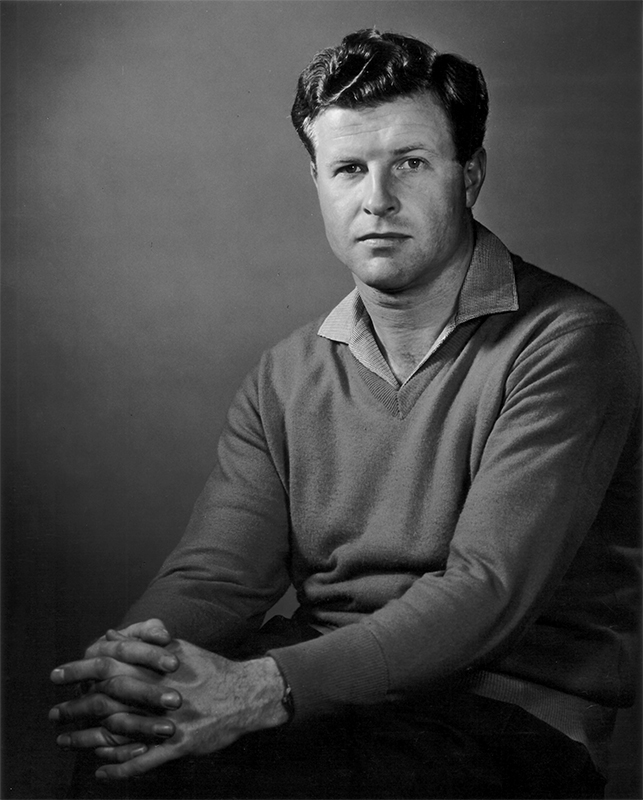 John
Anthony Randoll Blacking (22 October 1928 – 24 January 1990) was a
British ethnomusicologist and social anthropologist. Army in Malaysia,
he was employed by Hugh Tracey in the International Library of African
Music (ILAM) and further studied music and culture of the Venda people
in South Africa in the 1950s and 1960s. In 1965 he was awarded a
D.Litt. from the University of the Witwatersrand for his work on Venda
children's songs. In 1965 he was made professor and Head of the
Department of Social Anthropology.[1] In the field of ethnomusicology,
Blacking is known for his early and energetic advocacy of an
anthropological perspective in the study of music. He spent most of his
later academic career at Queen's University Belfast, in Northern
Ireland, where he was professor of social anthropology from 1970 until
his death in 1990. Many of his ideas about the social impact of music
can be found in his 1973 book How Musical is Man?. In this book,
Blacking called for a study of music as "Humanly Organized Sound",
arguing that "it is the activities of Man the Music Maker that are of
more interest and consequence to humanity than the particular musical
achievements of Western man",[2] and that "no musical style has 'its
own terms': its terms are the terms of its society and culture".[3] His
other books include Venda Children's Songs (1967), one of the first
ethnomusicological works to focus directly on the interpenetration of
music and culture, Anthropology of the Body (London: Academic Press,
1977) and A Commonsense View of All Music: reflections on Percy
Grainger's contribution to ethnomusicology and music education
(Cambridge: Cambridge University Press, 1989). The Callaway Centre in
University of Western Australia holds an archive of his field notes and
tapes, the John Blacking Collection. He wrote and presented a series,
Dancing, for Ulster Television. John Blacking House was named in
Belfast, in honour of his involvement with the Open Door Housing
Association. He died in Belfast at age 62 on 24 January 1990. John
Anthony Randoll Blacking (22 October 1928 – 24 January 1990) was a
British ethnomusicologist and social anthropologist. Army in Malaysia,
he was employed by Hugh Tracey in the International Library of African
Music (ILAM) and further studied music and culture of the Venda people
in South Africa in the 1950s and 1960s. In 1965 he was awarded a
D.Litt. from the University of the Witwatersrand for his work on Venda
children's songs. In 1965 he was made professor and Head of the
Department of Social Anthropology.[1] In the field of ethnomusicology,
Blacking is known for his early and energetic advocacy of an
anthropological perspective in the study of music. He spent most of his
later academic career at Queen's University Belfast, in Northern
Ireland, where he was professor of social anthropology from 1970 until
his death in 1990. Many of his ideas about the social impact of music
can be found in his 1973 book How Musical is Man?. In this book,
Blacking called for a study of music as "Humanly Organized Sound",
arguing that "it is the activities of Man the Music Maker that are of
more interest and consequence to humanity than the particular musical
achievements of Western man",[2] and that "no musical style has 'its
own terms': its terms are the terms of its society and culture".[3] His
other books include Venda Children's Songs (1967), one of the first
ethnomusicological works to focus directly on the interpenetration of
music and culture, Anthropology of the Body (London: Academic Press,
1977) and A Commonsense View of All Music: reflections on Percy
Grainger's contribution to ethnomusicology and music education
(Cambridge: Cambridge University Press, 1989). The Callaway Centre in
University of Western Australia holds an archive of his field notes and
tapes, the John Blacking Collection. He wrote and presented a series,
Dancing, for Ulster Television. John Blacking House was named in
Belfast, in honour of his involvement with the Open Door Housing
Association. He died in Belfast at age 62 on 24 January 1990. |
ジョン・アンソニー・ランドール・ブラッキング
(John Anthony Randoll Blacking、1928年10月22日 -
1990年1月24日)は、イギリスの民族音楽学者、社会人類学者である。マレーシアで陸軍に入り、ヒュー・トレーシーに雇われて国際アフリカ音楽図書館
(ILAM)に入り、さらに1950年代から1960年代にかけて南アフリカのヴェンダ族の音楽と文化を研究した。1965年、ヴェンダ族の子供の歌に関
する研究でウィットウォータースランド大学からD.Litt.を授与される。民族音楽学の分野では、音楽研究において人類学的な視点を早くから精力的に提
唱してきたことで知られている[1]。その後の学究生活の大半を北アイルランドのクイーンズ大学ベルファストで過ごし、1970年から1990年に亡くな
るまで、社会人類学の教授を務めた。音楽の社会的影響に関する彼の考えの多くは、1973年に出版された『人間はいかに音楽的か』に見ることができる。こ
の本でブラッキングは「人間的に組織された音」としての音楽の研究を呼びかけ、「人類にとってより興味深く重要なのは、西洋人の特定の音楽の業績よりも、
音楽製作者である人間の活動である」と主張し[2]、「どんな音楽スタイルも『それ
自身の条件』を持っていない:その条件はその社会と文化の条件である」
と述べている。 [3]
その他の著書に、音楽と文化の相互浸透に直接焦点を当てた最初の民族音楽学的著作の一つである『ヴェンダの子供の歌』(1967)、『身体の人類学』(ロ
ンドン:アカデミック出版、1977)、『すべての音楽の常識的見解:民族音楽学と音楽教育に対するパーシー・グレインジャーの貢献に関する考察』(ケン
ブリッジ:ケンブリッジ大学出版、1989)などがある。西オーストラリア大学のキャラウェイ・センターは、彼のフィールドノートとテープのアーカイブで
あるジョン・ブラッキング・コレクションを所蔵している。また、アルスター・テレビジョンで「ダンシング」シリーズを執筆、放映した。ジョン・ブラッキン
グ・ハウスは、彼のオープンドア住宅協会への関わりを称え、ベルファストに命名された。1990年1月24日、62歳でベルファストで死去。 John Blacking's "How Musical is Man?" | Audio Samples - UW Ethnomusicology Archives. |
| Sunsuke, TSURUMI, 1922-2015 |
鶴見俊輔(→シュンスケ・エン・メヒコ) |
|
| Alfred Clark (December 19, 1873 – June 16, 1950) | Alfred
Clark (December 19, 1873 – June 16, 1950) was a pioneer of music
recording and cinema. As a cameraman and director of productions at
Edison's first studio, he was the first to make moving pictures with
innovations like continuity, plot, trained actors and special
effects.[1] In 1896, he joined Emile Berliner's Gramophone Company and
then went to Europe where he became an important manager of companies
like His Master's Voice and EMI. He was naturalized as a British
citizen in 1928 and became a leading member of the Oriental Ceramic
Society in London, establishing a valuable collection including rare
pieces which had been made for the emperors of the Tang and Song
dynasty.[2] In 1921 he married Ivy Sanders, who survived him and died in 1973.[3] 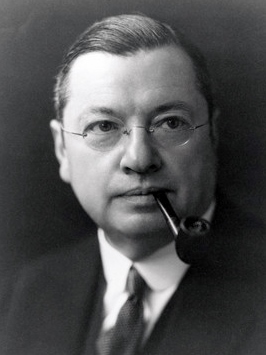 Early life Alfred Clark was born in New York on 19 December 1876. He was educated at the Franklin School in Washington and the City College of New York. He took an early interest in electricity and left college at sixteen to join the North American Phonograph Company. This collapsed in 1894 and Clark then joined Thomas Edison to make early short movies using the Kinetoscope technology at the Black Maria studio. Previously, Edison's output had been boxing and vaudeville but Clark introduced the first productions with continuity and plot such as the brief Execution of Mary Stuart which introduced the first special effect to show her decapitation.[1] Gramophone 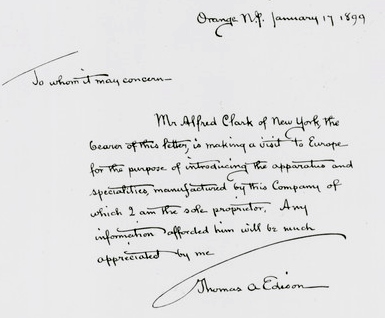 Letter of introduction given to Clark by Edison to help him get established in Europe Clark's main interest was sound recording so, after a year of pioneering cinema, he worked for Edison's phonograph company while taking evening classes at the Cooper Institute and collaborating with Emile Berliner and Eldridge Johnson on development of the gramophone – a superior technology to the phonograph, as it enabled mass production of recordings from a metal master. Clark's innovations included a governor to control the speed of playback and an improved sound box.[1] In 1899, Clark went to France, representing both Edison and Berliner. The gramophone technology did well, and Clark founded the Compagnie de Gramophone Française which recorded major artists such as Claude Debussy and Edvard Grieg. In 1904, Clark sold his French holdings for £23,000 and, in 1907, he helped establish the Musée de la Voix for which he was awarded the Legion of Honour. In 1908, he moved to Britain where he became the managing director of the Gramophone company there, reorganising it and establishing a factory in Hayes. The First World War was disruptive as the business had to focus on war work but Clark gained greater control of the company when the non-executive directors terminated his employment but found that the bank would not accept them as managers. Clark was rehired with better pay while the board was reorganised.[4] After the war, he developed the partnership with Eldridge Johnson's Victor Talking Machine Company and acquired the Marconiphone business for its new technologies of radio and electronics, which were now becoming important for home entertainment. In 1931, the business was merged with the Columbia Graphophone Company to form EMI. This focussed on cost-cutting and rationalisation to survive the Great Depression but continued to develop its technology, including television which the BBC started broadcasting using an EMI system in 1936. The Second World War interrupted such consumer developments as the business again had to switch to war work such as radar. Clark was the chairman and sometimes managing director during this period and he then retired in 1946.[1] Chinese ceramics Clark formed one of the most important Western collections of Chinese ceramics (though it was outshone by that of Sir Percival David). His first donation to the British Museum was a Ru ware brush-washer bowl in 1936; this was lent to an exhibition in the Palace Museum in Beijing in 2015–16.[5] This was one of a pair; the other was later sold to a Japanese collection. When sold again, on 4 April 2012 by Sotheby's in Hong Kong, it fetched 207,860,000 Hong Kong dollars (US$26.7 million), an auction record for Song ceramics.[6] Several other pieces from the Clark collection, including three Chinese paintings, were donated or sold to the British Museum, mostly by Mrs Clark in 1972.[7] There was a sale of much of the collection in 1956.[2] The rest of the collection was sold or donated by his widow during the 1970s, but is recorded in a catalogue by Edgar Bluett, first published as a series of articles in Apollo magazine.[8] Clark was on the Council of the Oriental Ceramic Society for most of the period 1934–48, and lent several pieces to the important Royal Academy of Arts exhibition of Chinese art in 1935–36.[9] As recalled by Lady David (wife of Sir Percival) in 1992, most of the collection was displayed in the living rooms, with a "little room upstairs" where their Song dynasty pieces were displayed. She described the collection as "small, formed by two people with extremely good taste".[10] Filmography These were the short films made for the Kinetoscope in 1895 at Edison's Black Maria studio. Historical Duration: 22 seconds.0:22 The Execution of Mary Stuart is the only surviving historical work.[11] It is now in the public domain and so can be viewed in full. A Frontier Scene[11] Indian Scalping Scene[11] Joan of Arc[11] Rescue of Capt. John Smith by Pocahontas[11] The Execution of Mary Stuart[11] Vaudeville Acrobatic Dance – the Leigh sisters[11] Cyclone Dance – dancer Lola Yberri[11] Fan Dance – dancer Lola Yberri[11] Umbrella Dance – the Leigh Sources "British Museum": Biography by the British Museum Martland, Peter (2004). "Clark, Alfred Corning (1873–1950)". Oxford Dictionary of National Biography (online ed.). Oxford University Press. doi:10.1093/ref:odnb/46816. (Subscription or UK public library membership required.) Martland, Peter (2013), Recording History – The British Record Industry, 1888-1931, Scarecrow Press, ISBN 9780810882522 Musser, Charles (1991), "Edison and the Kinetoscope", Before the Nickelodeon, University of California Press, ISBN 9780520060807 "Mr. Alfred Clark", The Times, p. 8, 19 June 1950 Pierson, Stacey, Collectors, Collections and Museums: The Field of Chinese Ceramics in Britain, 1560–1960, 2007, Peter Lang, ISBN 3039105388, 9783039105380, google books Vernoit, S. J. (2011), "Clark, Alfred", in Joan M. Marter (ed.), The Grove Encyclopedia of American Art, vol. 1, Oxford University Press, ISBN 9780195335798 https://en.wikipedia.org/wiki/Alfred_Clark_(director) |
アルフレッド・クラーク(1873
年12月19日 -
1950年6月16日)は音楽録音と映画のパイオニアである。1896年、エミール・ベルリナーのグラモフォン社に入社し、その後ヨーロッパに渡り、
His Master's
VoiceやEMIといった会社の重要なマネージャーとなった。1928年にイギリスに帰化し、ロンドンの東洋陶磁協会の主要メンバーとなり、唐や宋の皇
帝のために作られた貴重な作品を含む貴重なコレクションを確立した[2]。 1921年、アイビー・サンダースと結婚し、1973年に死去した[3]。  生い立ち アルフレッド・クラークは1876年12月19日にニューヨークで生まれた。ワシントンのフランクリン・スクールとニューヨーク・シティ・カレッジで教育 を受けた。早くから電気に興味を持ち、16歳で大学を中退してノース・アメリカン・フォノグラフ・カンパニーに入社した。この会社は1894年に倒産し、 クラークはその後トーマス・エジソンに加わり、ブラック・マリア・スタジオでキネトスコープ技術を使った初期の短編映画を製作した。それまでのエジソンの 作品はボクシングとボードビルだったが、クラークは、メアリー・スチュアートの断頭を見せる初の特殊効果を導入した短い『メアリー・スチュアートの処刑』 のような、連続性とプロットを持つ最初の作品を発表した[1]。 蓄音機  エジソンがクラークをヨーロッパに定着させるために贈った紹介状 クラークの主な関心は録音であったため、1年間の映画の開拓の後、エジソンの蓄音機会社で働きながら、クーパー・インスティテュートで夜間授業を受け、エ ミール・ベルリナーやエルドリッジ・ジョンソンと蓄音機の開発に協力した。クラークの技術革新には、再生速度を制御するガバナーや改良されたサウンドボッ クスなどがあった[1]。 1899年、クラークはエジソンとベルリナーの代理人としてフランスに渡った。蓄音機技術は好調で、クラークはCompagnie de Gramophone Françaiseを設立し、クロード・ドビュッシーやエドヴァルド・グリーグといった主要アーティストの録音を行った。1904年、クラークはフランス に所有していた資産を23,000ポンドで売却し、1907年には声楽博物館の設立に貢献し、レジオンドヌール勲章を授与された。1908年にはイギリス に移り、グラモフォン社の専務取締役に就任、同社を再編成し、ヘイズに工場を設立した。第一次世界大戦の影響で、事業は戦争作業に集中せざるを得なくなっ たが、クラークは社外取締役が彼の雇用を打ち切ったものの、銀行が彼らを経営者として認めなかったため、会社の支配力を高めた。取締役会が再編される一方 で、クラークはより良い報酬で再雇用された[4]。 戦後、彼はエルドリッジ・ジョンソンのビクター・トーキング・マシン社との提携を発展させ、ホームエンターテイメントで重要となっていたラジオとエレクト ロニクスの新技術のためにマルコニフォン事業を買収した。1931年、事業はコロムビア・グラフォフォン・カンパニーと合併し、EMIが設立された。 EMIは世界恐慌を乗り切るため、コスト削減と合理化に注力したが、1936年にBBCがEMIのシステムを使用して放送を開始したテレビなど、技術開発 は継続した。第二次世界大戦が勃発すると、EMIの事業は再びレーダーなどの戦争関連事業に切り替えざるを得なくなり、消費者向けの開発は中断された。ク ラークはこの時期、会長と時には専務取締役を務め、1946年に引退した[1]。 中国陶磁 クラークは、西洋における中国陶磁の最も重要なコレクションのひとつを形成していた(サー・パーシヴァル・デイヴィッドのコレクションには負けるが)。大 英博物館への最初の寄贈は1936年の汝窯の筆洗鉢で、これは2015年から16年にかけて北京の故宮博物院で開催された展覧会に貸し出された[5]。 2012年4月4日に香港のサザビーズで再び売却された際には、2億786万香港ドル(2,670万米ドル)の値がつき、宋の陶磁器のオークション記録と なった[6]。3点の中国絵画を含むクラーク・コレクションの他のいくつかの作品は、1972年に主にクラーク夫人によって大英博物館に寄贈または売却さ れた。 [7]1956年にはコレクションの多くが売却された[2]。残りのコレクションは1970年代に未亡人によって売却または寄贈されたが、『アポロ』誌に 連載されたエドガー・ブルエットによるカタログに記録されている[8]。 クラークは1934年から48年のほとんどの期間、東洋陶磁協会の評議員を務め、1935年から36年にかけて開催された中国美術の重要なロイヤル・アカ デミー・オブ・アーツ展に数点を貸し出した[9]。1992年にレディ・デイヴィッド(サー・パーシヴァルの妻)が回想しているように、コレクションのほ とんどは居間に飾られ、「2階の小さな部屋」には宋時代の作品が飾られていた。彼女はコレクションを「非常に趣味の良い二人によって形成された小さなも の」と表現した[10]。 フィルモグラフィ これらは、1895年にエジソンのブラック・マリア・スタジオでキネトスコープ用に製作された短編映画である。 歴史的 上映時間:22秒0:22 メアリー・スチュアートの処刑』は、現存する唯一の歴史的作品である[11]。 現在はパブリックドメインとなっているため、全編を見ることができる。 辺境のシーン[11] インディアンの略奪シーン[11] ジョーン・オブ・アーク[11] ポカホンタスによるジョン・スミス大尉の救出[11]。 メアリー・スチュアートの処刑[11] ボードヴィル アクロバットダンス - リー姉妹[11] サイクロン・ダンス-ダンサー、ローラ・イベリ[11]。 ファン・ダンス - ダンサー、ローラ・イベリ[11] アンブレラダンス - リー姉妹 情報源 「大英博物館 大英博物館による伝記 Martland, Peter (2004). 「Clark, Alfred Corning (1873-1950)」. Oxford Dictionary of National Biography(オンライン版). doi:10.1093/ref:odnb/46816. (購読または英国公共図書館の会員登録が必要) Martland, Peter (2013), Recording History - The British Record Industry, 1888-1931, Scarecrow Press, ISBN 9780810882522. Musser, Charles (1991), 「Edison and the Kinetoscope」, Before the Nickelodeon, University of California Press, ISBN 9780520060807 「アルフレッド・クラーク氏」、タイムズ紙、8頁、1950年6月19日 Pierson, Stacey, Collectors, Collections and Museums: The Field of Chinese Ceramics in Britain, 1560-1960, 2007, Peter Lang, ISBN 3039105388, 9783039105380, google books. Vernoit, S. J. (2011), 「Clark, Alfred」, in Joan M. Marter (ed.), The Grove Encyclopedia of American Art, vol. 1, Oxford University Press, ISBN 9780195335798 |
文献リスト
| ●収集文献リスト 1) イーストウッドの男たち : マスキュリニティの表象分析 / ドゥルシラ・コーネル著 ; 志田陽子 [ほか] 訳,東京 : 御茶の水書房 , 2011.3 2) 甘さと権力 : 砂糖が語る近代史 / シドニー・W・ミンツ著 ; 川北稔, 和田光弘訳, 東京 : 筑摩書房 , 2021.5. - (ちくま学芸文庫 ; [ミ26-1]) 3) Jeffrey B Frazier, Q'eqchi' Pocket Dictionary. 9781648090035 4) Salome Voegelin, Sonic Possible Worlds: Hearing the Continuum of Sound. 9781501367625 5) イタリア・ルネサンスの霊魂論 : フィチーノ・ピコ・ポンポナッツィ・ブルーノ / 根占献一 [ほか] 著, 三元社 , 2013 4) 貧困の文化 / オスカー・ルイス著 ; 高山智博, 染谷臣道, 宮本勝訳, 東京 : 筑摩書房 , 2003.6. - (ちくま学芸文庫) 5) ラ・ビーダ : プエルト・リコの一家族の物語 / オスカー・ルイス [著] ; 行方昭夫, 上島建吉訳, 1,2,3. - 東京 : みすず書房 , 1970.10-1971.3. - (みすず叢書 ; 31-33) 6) キューバ 革命の時代を生きた四人の男 : スラムと貧困現代キューバの口述史 / オスカー・ルイス, ルース・M.ルイス, スーザン・M.リグダン著 ; 江口信清訳, 明石書店 , 2007 7) . サンチェスの子供たち : メキシコの一家族の自伝 / オスカー・ルイス [著] ; 柴田稔彦, 行方昭夫共訳, みすず書房 , 1986 8) Ritual humor in highland Chiapas / by Victoria Reifler Bricker, University of Texas Press , 1973 . - (The Texas Pan American series) . - (Texas Press sourcebooks in anthropology). 9) 黄泉 (よみ) からの声 : 妖怪ハンター : 稗田礼二郎のフィールド・ノートより / 諸星大二郎著, 集英社 , 1994 . - (Young jump comics wide) 10) Wittgenstein Wittgenstein, Remarks on Colour. 9780520251793 11) Man, God, & immortality : thoughts on human progress / Sir James George Frazer, Kessinger , Macmillan , 1927. 12) The man who mistook his wife for a hat and other clinical tales / Oliver Sacks. Simon & Schuster , 1998 . - (A Touchstone book) 13) Taming the wind of desire : psychology, medicine, and aesthetics in Malay shamanistic performance / Carol Laderman. University of California Press , 1991 . - (Comparative studies of health systems and medical care) 14) 感情史の始まり / ヤン・プランパー [著]東京 : みすず書房 , 2020.11 15) Jazz cosmopolitanism in Accra : five musical years in Ghana / Steven Feld. Duke University Press , 2012 16) 大いなる歌 / パブロ・ネルーダ著 ; 松本健二訳. 東京 : 現代企画室 , 2018.9. - (ロス・クラシコス / 寺尾隆吉企画・監修 ; 12) 17)Barbara J. Crowe. Music And Soulmaking: Toward a New Theory of Music Therapy.Scarecrow Pr (2004/12/30). 9780810851436 18) The smell culture reader / edited by Jim Drobnick. Berg , 2006 . - (Sensory formations series). 19) Altered states of consciousness : a book of readings / Charles T. Tart, editor. Wiley , 1969 20) Sound and sentiment : birds, weeping, poetics, and song in Kaluli expression / Steven Feld. Duke University Press , 2012. 21) E. Schieffelin. The Sorrow of the Lonely and the Burning of the Dancers. Palgrave Macmillan; 2nd ed. 2005版 (2005/1/31) 22) Music, culture, & experience : selected papers of John Blacking / edited and with an introduction by Reginald Byron ; with a foreward by Bruno Nettl. University of Chicago Press , 1995 . - (Chicago studies in ethnomusicology) 23) The color of angels : cosmology, gender, and the aesthetic imagination / Constance Classen. Routledge , 1998 24) Gerardo Villadelangel Vinas, Roger Bartra. Axolotiada: Vida y mito de un anfibio mexicano / Life and Myth of the Mexican Amphibian (Tezontle).Fondo De Cultura Economica USA (2011/8/16) 25) The performing arts : music and dance / editors, John Blacking, Joann W. Kealiinohomoku. The Hague ; New York : Mouton , c1979. - (World anthropology) 26) The power of the between : an anthropological odyssey / Paul Stoller. University of Chicago Press , 2009 27) Oliver Sacks. Musicophilia: Tales of Music and the Brain. Knopf Canada (2007/10/16) 28) シンコペーション : ラティーノ/カリビアンの文化実践 / 杉浦勉, 鈴木慎一郎, 東琢磨編著. エディマン , 2003 . - (Flash! Forward, 01) 29) Heidegger's phenomenology of perception / David Kleinberg-Levin. Rowman & Littlefield International , 2020 30) 模倣と他者性 : 感覚における特有の歴史 / マイケル・タウシグ著 ; 井村俊義訳. 水声社 , 2018 . - (人類学の転回叢書) 31) Serving the word : literalism in America from the pulpit to the bench / Vincent Crapanzano. New Press , 2000 32) The anthropology of cannibalism / edited by Laurence R. Goldman. Westport, CT : Bergin & Garvey , 1999 33) Defacement : public secrecy and the labor of the negative / Michael Taussig. Stanford University Press , 1999 34) Cannibalism : human aggression and cultural form / Eli Sagan ; foreword by Robert N. Bellah. Harper & Row , 1974 . - (Harper torchbooks, TB 1830) 35) The cage of melancholy : identity and metamorphosis in the Mexican character / Roger Bartra ; translated by Christopher J. Hall. Rutgers University Press , 1992 35) Making sense of taste : food and philosophy / Carolyn Korsmeyer. Cornell University Press , 1999 36) 音楽嗜好症 (ミュージコフィリア) : 脳神経科医と音楽に憑かれた人々 / オリヴァー・サックス著 ; 大田直子訳. 早川書房 , 2014 . - (ハヤカワ文庫, 7418 . ハヤカワ文庫NF ; NF414) 37) 精神分析の四基本概念 / ジャック・ラカン [著] ; ジャック=アラン・ミレール編 ; 小出浩之 [ほか] 訳. 岩波書店 , 2020 . - (岩波文庫, 青N(38)-603-2) 38) Icanchu's drum : an orientation to meaning in South American religions / Lawrence E. Sullivan. Macmillan , 1988 39) Law in a lawless land : diary of a limpieza in Colombia / Michael Taussig. University of Chicago Press , 2005 40) The magic of the state / Michael Taussig. New York ; London : Routledge , 1997 41) After the beautiful : Hegel and the philosophy of pictorial modernism / Robert B. Pippin. University of Chicago Press , 2014 42) Angels in mourning : sublime madness, ennui and melancholy in modern thought / Roger Bartra ; [English translation by Nick Caistor]. Reaktion Books , 2018 43) The people of the Sierra / J. A. Pitt-Rivers ; introduction by E.E. Evans-Pitchard. Criterion Books , 1954 44) Maya resurgence in Guatemala : Q'eqchi' experiences / Richard Wilson. University of Oklahoma Press , c1995 45) 共同-体(コルプス) / ジャン=リュック・ナンシー著 ; 大西雅一郎訳, 松籟社 , 1996 46)An analysis of Oliver Sacks's the Man who mistook his wife for a hat and other clinical tales / Dario Krpan with Alexander J. O'Connor. Routledge , 2017 . - (The Macat library) 47) Reggaeton / edited by Raquel Z. Rivera, Wayne Marshall, and Deborah Pacini Hernandez. Duke University Press , 2009 . - (Refiguring American music) 48) Dialectics and gender : anthropological approaches / edited by Richard R. Randolph, David M. Schneider, and May N. Diaz. Westview Press , 1988 49) The navigation of feeling : a framework for the history of emotions / William M. Reddy. New York : Cambridge University Press , 2001 50) 音楽嗜好症 (ミュージコフィリア) : 脳神経科医と音楽に憑かれた人々 / オリヴァー・サックス著 ; 大田直子訳. 東京 : 早川書房 , 2010.7 51) 人間の音楽性 / J. ブラッキング著 ; 徳丸吉彦訳. 東京 : 岩波書店 , 1978.11. - (岩波現代選書 ; 21) 52) テキーラとメスカル : 同じ起源をもつアガベ・スピリッツ / サラ・ボーウェン著 ; 小澤卓也, 立川ジェームズ, 中島梓訳. ミネルヴァ書房 , 2021 53) Introducing Shakespeare / Nick Groom ; and [illustrated by] Piero ; edited by Richard Appignanesi. Icon , 2001 54) How musical is man? / John Blacking. University of Washington Press , 1974 . - (The John Danz lectures, WP-72) . - (Washington paperbacks) 55) Hybrid ethnography : online, offline, and in between / Liz Przybylski. SAGE , 2021 . - (Qualitative research methods, v. 58) 56) Anthropology of the brain : consciousness, culture, and free will / Roger Bartra ; translated by Gusti Gould. ambridge University Press , 2014 57) Vaike Fors, Sarah Pink et al., Imagining Personal Data: Experiences of Self-Tracking. Routledge, 2020. 58) Time and the highland Maya / Barbara Tedlock ; [foreword by Nathaniel Tarn]. University of New Mexico Press , 1992 59) The taste of ethnographic things : the senses in anthropology / Paul Stoller. University of Pennsylvania Press , 1989 . - (Contemporary ethnography series) 60) メヒコの衝撃 : メキシコ体験は日本の根底を揺さぶる / 北川民次 [ほか作] ; 市原湖畔美術館, 現代企画室編, 市原湖畔美術館 , 2021 61) Uncertainty and possibility : new approaches to future making in design anthropology / Yoko Akama, Sarah Pink and Shanti Sumartojo. Bloomsbury Academic , 2018 62) Anthropologies and futures : researching emerging and uncertain worlds / edited by Juan Francisco Salazar...[et al.]. Bloomsbury Academic, an imprint of Bloomsbury Pub , 2017 63) Consequences of contact : language ideologies and sociocultural transformations in Pacific societies / edited by Miki Makihara, Bambi B. Schieffelin. Oxford : Oxford University Press , 2007 64)北川民次美術教育論集 / 北川民次著, 東京 : 創風社, 上・下, 1998. 65) Raquel Romberg, Healing Dramas: Divination and Magic in Modern Puerto Rico. Univ of Texas Pr (2009/4/1) 66) Lilia D. Monzó. A Revolutionary Subject: Pedagogy of Women of Color and Indigeneity (Education and Struggle: Narrative, Dialogue, and the Political Production of Meaning) Peter Lang Pub Inc; New版 (2019/5/24). 67) In sorcery's shadow : a memoir of apprenticeship among the Songhay of Niger / Paul Stoller and Cheryl Olkes. University of Chicago Press , 1989 68) 響きあう身体 : 音楽・グルーヴ・憑依 / 山田陽一著, 春秋社 , 2017 69) Doing sensory ethnography / Sarah Pink. SAGE , 2015 70) Doing visual ethnography / Sarah Pink. SAGE Publications , 2021 71) Jeffrey Frazier. Q'eqchi' Pocket Phrasebook. Independently published (2018/12/21) 72) 意味について / アルジルダス・ジュリアン・グレマス著 ; 赤羽研三訳. 水声社 , 1992 . - (叢書記号学的実践, 16) 73) うさぎのみみはなぜながい / 北川民次ぶんとえ. 福音館書店 , 1962 . - (日本傑作絵本シリーズ) 74) 進化地図 / ロジャー・オズボーン, マイケル・ベントン著 ; 池田比佐子訳, 河出書房新社 , 2011 75) 船の救世主 / ロドリゴ・レイローサ著 ; 杉山晃訳, 現代企画室 , 2000 76) アフリカの海岸 / ロドリゴ・レイローサ著 ; 杉山晃訳, 現代企画室 , 2001 77) Sam Vaknin , Lidija Rangelovska, Malignant Self-love: Narcissism Revisited. Independently published, 2015 78) The Puerto Rican nation on the move : identities on the island & in the United States / Jorge Duany. niversity of North Carolina Press , 2002 79) 個人的なことと政治的なこと : ジェンダーとアイデンティティの力学 / 井川ちとせ, 中山徹編著, 東京 : 彩流社 , 2017.3 80) Naven : a survey of the problems suggested by a composite picture of the culture of a New Guinea tribe drawn from three points of view / by Gregory Bateson. 2nd ed. - Stanford, Calif. : Stanford University Press , c1958 81) Sensory marketing : theoretical and empirical grounds / Bertil Hultén. Routledge , 2018 . - (Routledge interpretive marketing research series, 21) 82) Ways of sensing : understanding the senses in society / David Howes and Constance Classen. Routledge , 2014 83) Jeffrey B Frazier, Q'eqchi' Mayan Dictionary: Second Edition - Revised and Expanded. Omnilex Media (2021/3/20) 84) 世界の調律 : サウンドスケープとはなにか / R.マリー・シェーファー著 ; 鳥越けい子 [ほか] 訳, 東京 : 平凡社 , 1986.12. - (テオリア叢書) 85) The soundscape : our sonic environment and the tuning of the world / R. Murray Schafer. Destiny Books , 1994 86) テキーラの歴史 / イアン・ウィリアムズ著 ; 伊藤はるみ訳, 原書房 , 2019 . - (「食」の図書館) 87) Digital ethnography : principles and practice / Sarah Pink ... [et al.], SAGE , 2016 88) The book of touch / edited by Constance Classen. Berg , 2005 . - (Sensory formations series) 89) CASTANEDA PARA PRINCIPIANTES, 9789875550278 90) ハンズ : 手の精神史 / ダリアン・リーダー著 ; 松本卓也, 牧瀬英幹訳, 左右社 , 2020 91) 匂いの人類学 : 鼻は知っている / エイヴリー・ギルバート著 ; 勅使河原まゆみ訳. ランダムハウス講談社 , 2009 92) What the nose knows : the science of scent in everyday life / Avery Gilbert. Crown Publishers , 2008 93) 叢書『アナール1929-2010』 : 歴史の対象と方法. 藤原書店 , 1と2巻, 2010 94) 初めに愛があった : 精神分析と信仰 / ジュリア・クリステヴァ [著] ; 枝川昌雄訳. 法政大学出版局 , 1987 . - (叢書・ウニベルシタス, 215) 95) チェ・ゲバラの影の下で : 孫・カネックのキューバ革命論 / カネック・サンチェス・ゲバラ著 ; 棚橋加奈江訳. 現代企画室 , 2018 . - (インディアス群書, 17) 96) 時間と自由 / ベルクソン [著] ; 平井啓之訳 . アリストテレスの場所論 / ベルクソン [著] ; 村治能就, 広川洋一共訳. 東京 : 白水社 , 1965.5. - (ベルクソン全集(「ベルグソン」と表記されている) ; 1) 97) Karen Bray et al., Religion, Emotion, Sensation: Affect Theories and Theologies (Transdisciplinary Theological Colloquia) Fordham University Press; 第1版 (2019/12/3) 98) Culture and politics : identity and conflict in a multicultural world / edited by Rik Pinxten, Ghislain Verstraete and Chia Longman. Berghahn Books , 2004 . - (Culture and politics/politics and culture, v. 2) 99) The anthropology of food and body : gender, meaning, and power / Carole M. Counihan. Routledge , 1999 100) We are left without a father here : masculinity, domesticity, and migration in postwar Puerto Rico / Eileen J. Suárez Findlay. Duke University Press , 2014 . - (American encounters/global interactions) 101) Jessica M. Mulligan. Unmanageable Care: An Ethnography of Health Care Privatization in Puerto Rico. NYU Press (2014/8/8) 102) Empire of the senses : sensory practices of colonialism in early America / edited by Daniela Hacke, Paul Musselwhite. Brill , 2018 . - (Early American history series : the American colonies, 1500-1830 / edited by Jaap Jacobs, L. H. Roper, Bertrand Van Ruymbeke, v. 8). 102) The museum of the senses : experiencing art and collections / Constance Classen. Bloomsbury Academic , 2017 . - (Sensory studies series / general editor, David Howes) 103) T. Castanha. The Myth of Indigenous Caribbean Extinction: Continuity and Reclamation in Borikén. Palgrave Macmillan; 第2011版 (2010/12/14) 104) Popol vuh : the sacred book of the Maya / Allen J. Christenson. University of Oklahoma Press , 2007 105) ポポル・ヴフ : マヤ文明の古代文書 / レシーノス校註 ; 林屋永吉訳, 東京 : 中央公論社 , 1961.6 106) ヒップホップ・モンゴリア : 韻がつむぐ人類学 / 島村一平著. 青土社 , 2021 107) 感性の歴史 / L・フェーヴル, G・デュビィ, A・コルバン[著] ; 小倉孝誠編集・訳 ; 大久保康明, 坂口哲啓訳, 東京 : 藤原書店 , 1997. 108) 妻を帽子とまちがえた男 / オリヴァー・サックス著 ; 高見幸郎, 金沢泰子訳. 早川書房 , 2009 . - (ハヤカワ文庫, NF353) 109) サイバネティックス : 動物と機械における制御と通信 / ウィーナー [著] ; 池原止戈夫 [ほか] 訳. 岩波書店 , 2011 . - (岩波文庫, 青(33)-948-1) 110) かも猟 / クラウス [著] . 共同墓地 / トロワイヤ [著] . エロチシズム / デスノス [著] . 悲惨物語 / サド [著] . 支那の占星学者 : 補遺 / フェリイ [著](澁澤龍彦翻訳全集 / 澁澤龍彦訳 ; 3), 東京 : 河出書房新社1997. 111) Jeffrey B Frazier. Q'eqchi' Mayan Thematic Dictionary: Tusb'il Molob'aal Aatin Q'eqchi', CreateSpace Independent Publishing Platform; Bilingual版 (2015/6/21) 112) Looking for Spinoza : joy, sorrow, and the feeling brain / Antonio Damasio. Harcourt , 2003 . - (A Harvest/HBJ book) 113) Remixing reggaetón : the cultural politics of race in Puerto Rico / Petra R. Rivera-Rideau. Duke University Press , 2015 114) Carole Counihan (編集), Susanne Højlund (編集) Making Taste Public: Ethnographies of Food and the Senses. Bloomsbury USA Academic (2018/8/9) 115) Elizabeth Zelensky. Windows to Heaven: Introducing Icons To Protestants And Catholics. Brazos Press (2005/2/1) 116) フーディー : グルメフードスケープにおける民主主義と卓越化 / ジョゼ・ジョンストン, シャイヨン・バウマン著 ; 村井重樹 [ほか] 訳, 青弓社 , 2020 117) The senses still : perception and memory as material culture in modernity / edited by C. Nadia Seremetakis. University of Chicago Press , 1996 118) Sensory biographies : lives and deaths among Nepal's Yolmo Buddhists / Robert Desjarilais. University of California Press , 2003 . - (Ethnographic studies in subjectivity, 2) 119) Women of the grassfields : a study of the economic position of women in Bamenda, British Cameroons / by Phyllis M. Kaberry ; with a pref. by Daryll Forde. H.M.S.O. , 1952 . - (Colonial research publications, no. 14) 120) Sonic bodies : reggae sound systems, performance techniques, and ways of knowing / by Julian Henriques. Continuum , 2011 121) Listening to noise and silence : towards a philosophy of sound art / by Salomé Voegelin, Continuum , 2010 122) 音楽の風土 : 革命は短調で訪れる / 五十嵐一著, 東京 : 中央公論社 , 1984.8. - (中公新書 ; 737) 123) Mastery of non-mastery in the age of meltdown / Michael Taussig. University of Chicago Press , 2020 124) Palma africana / Michael Taussig. University of Chicago Press , 2018 125) The economics of ecstasy : tantra, secrecy, and power in colonial Bengal / Hugh B. Urban. Oxford University Press , 2001 126) 神経心理学の基礎 : 脳のはたらき / ルリヤ著 ; 鹿島晴雄訳, 創造出版 , 1999 . - (創造医学選書) 127) Rafael Ocasio. Race and Nation in Puerto Rican Folklore: Franz Boas and John Alden Mason in Porto Rico. Rutgers Univ Pr (2020/8/14) 128) The man-eating myth : anthropology & anthropophagy / W. Arens. Oxford University Press , 1979 129) 幻獣辞典 / ホルヘ・ルイス・ボルヘス著 ; 柳瀬尚紀訳 ; スズキコージ絵, 晶文社 , 2013 130) 記憶と近代 : ラテンアメリカの民衆文化 / ウィリアム・ロウ, ヴィヴィアン・シェリング著 ; 澤田眞治, 向山恭一訳, 現代企画室 , 1999 . - (インディアス群書, 20) 131) グローバル時代の歴史学 / リン・ハント [著] ; 長谷川貴彦訳, 岩波書店 , 2016 132) Writing history in the global era / Lynn Hunt. W.W. Norton , 2015 . - (A Norton paperback) 133) History : why it matters / Lynn Hunt. Polity , 2018 . - (Why it matters) 134) Early anthropology in the sixteenth and seventeenth centuries / by Margaret T. Hodgen. University of Pennsylvania Press , 1964. 135) On decoloniality : concepts, analytics, praxis / Walter D. Mignolo and Catherine E. Walsh. Duke University Press , 2018 . - (On decoloniality / a series edited by Walter D. Mignolo and Catherine E. Walsh) 136) 歴史のための闘い / リュシアン・フェーヴル著 ; 長谷川輝夫訳, 平凡社 , 1995 . - (平凡社ライブラリー, 101) 137) 色のない島へ : 脳神経科医のミクロネシア探訪記 / オリヴァー・サックス著 ; 春日井晶子訳, 早川書房 , 2015 . - (ハヤカワ文庫, NF 426) 138) World music : a very short introduction / Philip V. Bohlman. Oxford University Press , 2002 . - (Very short introductions, 65) 139)知恵の樹 / H. マトゥラーナ, F. バレーラ著 ; 管啓次郎訳, 筑摩書房 , 1997 . - (ちくま学芸文庫) 140) 年をとったワニの話 / レオポルド・ショヴォー作 ; 出口裕弘訳, 福音館書店 , 2002 . - (福音館文庫, S-10 . ショヴォー氏とルノー君のお話集 ; 1) 141) The Routledge companion to digital ethnography / edited by Larissa Hjorth ... [et al.]. Routledge , 2019 . - (Routledge companions) 142) Florence Babb. Women and Men in Vicos, Peru: A Case of Unequal Development. Michigan Feminist Studies (1980/12/1). 1980/12/1. ISBN-13: 978-9993146629 143) 聞こえくる過去 : 音響再生産の文化的起源 / ジョナサン・スターン [著] ; 中川克志, 金子智太郎, 谷口文和訳. インスクリプト , 2015 144) Engendering Mayan history : Kaqchikel women as agents and conduits of the past, 1875-1970 / David Carey, Jr. Routledge , 2006. 145) 滝奈々子・池田光穂「音と感覚のエスノグラフィー : マヤ・ケクチの民族音楽学」(大阪大学リポジトリー, 2021:https://doi.org/10.18910/85580) 146) チェコ構造美学論集 : 美的機能の芸術社会学 / ヤン・ムカジョフスキー著 ; 平井正, 千野栄一訳, せりか書房 , 1975年 147)メヒコの時間 : 革命と新大陸 / カルロス・フェンテス著 ; 西沢竜生訳, 新泉社 , 1975年 148) The Gutenberg galaxy : the making of typographic man / Herbert Marshall Mcluhan, [New York] : The New American Library , [1969]. - (A Mentor book) 149)Understanding media : the extensions of man / by Marshall McLuhan, New York : McGraw-Hill , c1964. 150)The global village : transformations in world life and media in the 21st century / Marshall McLuhan and Bruce R. Powers, pbk. - New York : Oxford University Press , 1992. - (Communication and society). - (Oxford paperbacks)// グローバル・ヴィレッジ : 21世紀の生とメディアの転換 / マーシャル・マクルーハン, ブルース・R・パワーズ著 ; 浅見克彦訳, 東京 : 青弓社 , 2003年 151) ベルクソニズム : 新訳 / ジル・ドゥルーズ [著] ; 檜垣立哉, 小林卓也訳, 法政大学出版局 , 2017年/ Le bergsonisme / par Gilles Deleuze. Paris : Presses universitaires de France , 1966[フ ランス語原著 pdf] |

池田光穂(原案)「中米・カリブにおける感 覚のエスノグラフィーに関する実証研究」
Empirical study on the ethnography of the senses in Central America and the Caribbean
この研究は中米・カリブにおける音楽・ダンス・絵画や写真等の表象芸術を中心としたポピュラーカルチャー
現象に焦点を当てD・ハウズのセンススケープを描写する「感覚のエスノグラフィー」の開発に挑戦したものである。グアテマラではケクチ先住民の民族音楽を
演奏者の身体感覚と伝統の継承から分析し、カリブ海沿岸のガリフナ文化では絵画描写と表現技法とその消費を明らかにし、プエルトリコではレゲトンとサルサ
という音楽をそれぞれアフロ感覚とソネオの口承伝統との交錯という点を分析しその成果を発表した。
This study challenged the development of an
‘ethnography of the senses’ that describes D. Howes' sensescapes,
focusing on popular culture phenomena in the Central America and the
Caribbean, particularly in the representational arts such as music,
dance, painting and photography. In Guatemala, we analyzed the folk
music of the Q'ueq'chi indigenous people in terms of the performers'
physical sensations and the transmission of traditions; in the Garifuna
culture of the Caribbean coast, we clarified pictorial depiction and
expressive techniques and their consumption; and in Puerto Rico, we
analyzed the music of reggaeton and salsa in terms of their
intersection with the Afro sensibility and Soneo oral tradition,
respectively, and presented the results in various academic media.
感覚の人類学研究は、身体論、現象学、宗教、移民などとそこから派生する固有のテーマをもち、その対象地
域は、西洋世界あるいは非工業化していない非西洋社会を対象にしてきた。この研究では先住民音楽のインターネットでの情報発信、伝統絵画ではなくペイント
をつかった商業あるいは非商業的な壁画、レゲトンやサルサなどローカルな演奏文脈からメディアを通した情報発信とその消費など、をそれぞれの感覚経験とど
のように交錯するかについて考察している。ネット社会における情報の圧縮と、携帯端末というメディアを通した直接感覚経験を直結した紋切り型でない分析方
法を提案している点で斬新である。
★F-19-1
1)研究開始当初の背景
(1)感覚の人類学研究に対する期待
研究当初のこの研究計画では、中米グアテマラ共和国とプエルトリコ、ホンジュラスをフィールドとして、 おもにマヤ系ならびにガリフナ民族とメスティソにおける音楽・ダンス・絵画や写真等の表象芸術を中心としたポピュラーカルチャー現象に焦点を当てた「感覚 のエスノグラフィー」の記述法の開発に挑戦する。すなわち、従来の書記法に加えて「感覚のエスノグラフィー」という観点を取り入れ、先住民社会におけるポ ピュラーカルチャーとりわけ、音楽・食・絵画・写真・ダンスなどの民族表象が、外部社会との接続により様々な文化要素の世界循環するさまを、先住民社会な らびにその民族表象を受け入れる若者を中心とした感覚の語りや経験に焦点をあてて考察する、というものであった。
その時代背景には、このテーマに対する学界からの期待があったからである。感覚経験の人類学とは、感覚 /感性のエスノグラフィーの記述を試み、そこから得られるデータを比較検証し、感覚経験の経験主義的理解を深める理論的貢献に挑戦する分野である。
(2)センススケープ論に着目して
感覚のエスノグラフィーとは、David Howes(2005)によるとセンススケープ(sense-scape)の描写すなわち書記法のことである。エスノグラフィーとは、フィールドワークと いう経験的調査手法を通して、人々の社会生活について具体的に書かれた「体系的体裁によって」整えられた記述のことである。「民族誌」は、完全な同義語で ある。したがって、エスノグラフィーとは、近代社会における「書記法・ライティング(writing)」に関わることになることも当然予想された。
さて、他方でセンススケープはアルジュン・アパデュライ(Arjun Appadurai, 1996 )によると、彼が提唱した5つのスケープ(ethno-, media-, techno-, finance-, ideo- scape)[2004:69]に加えたモダニティの第6のスケープ(sixth scape)と称されるものとされた。この研究は民族音楽のSteven Feld, 視覚表象のOliver Sacks, メディアのMarshall McLuhan らによって先鞭がつけられ、記憶における Susan Stewart, シャーマンのフェミニニティにおけるSusan Stewart、料理における Lisa Law, 匂い経験の Jim Drobnick などの野心的な研究が続いていた。
そのため、民族音楽学者、文化人類学者、歴史研究者がそれぞれ、共通の理論的枠組みを共有し、それぞれ
が持っている学問分野の方法論でアプローチするとともに、各研究者が自分の分野がもつパラダイムの限界を超えて領域横断的なこの研究領域でオリジナルのア
イディアを生産することが求められた。
2)研究の目的
最初になぜ感覚の人類学が重要なテーマになりえるのか?ということを、研究班で研究初年度にブレインス トーミングした。そこで次の5つの段階を通して「感覚経験のエスノグラフィー」が必要になることを確認した。その5つの目標(段階)とは以下のとおりであ る;1)感覚の人類学とは、人間の身体の人類学的研究であることを認識する。2)身体の人類学研究には、さまざまな学問領域(医学、心理学、教育学、芸術 学、哲学、そして文化研究)からのアプローチが必要である。3)身体の人類学の必要性はなぜか?——それは人間の身体や五感(=おもに感覚経験を形づくる ものと言われているもの)の普遍性ならびに斉一性と、感覚を含む身体経験が文化の違いにより非常に多様な姿=現象を取りうることが仮説として考えられるか ら。それゆえ、4)人間の身体や五感(=おもに感覚経験を形づくるものと言われているもの)の普遍性ならびに斉一性を基準にして、感覚を含む身体経験の文 化的に多様な形態を記述する方法を探究する必要がある。5)これらの方法は、感覚経験のエスノグラフィーを書く(writing ethnography of sensory experience)というプロセスから導き出されるという予測を立てた。
つまり、感覚経験のエスノグラフィーの書記法(writing)のシステムとその書記法を支える理論的
枠組みを、事例研究を通して探求されなければならないという結論に到達した。それが本研究の目的である。
3)研究の方法
上掲のように、研究の目的は、感覚経験のエスノグラフィーの書記法(writing)のシステムとその 書記法を支える理論的枠組みを、事例研究を通して探求することであった。そのための方法は以下の5つの柱からなる。
(1)先行研究の文献レヴュー
感覚の人類学研究とは、人間の身体の普遍性ならびに斉一性を基準にして、感覚を含む身体経験の文化的に 多様な形態を、経験的に明らかにしてきた「人間の身体に関する記述体(writing corps on human corps)」に関する文献レヴューをおこなう。
(2)先行研究カテゴリーの分類
すでに存在している、感覚経験のエスノグラフィーの文献的渉猟と、いくつかの(手本になる)代表作を仔 細に分析して、どのようにして、そのような感覚経験を記述することが可能になったのかについて考察する必要。特色となる感覚記述とその成功の可否の理由を 探究し、それらの間に、研究アプローチの違いを析出する。つまり、先行研究をなんらかの形で分類することを試みる。
(3)感覚と情動現象のモデル探求のための議論
感覚経験のエスノグラフィーの評価を質的な良さ/悪さだけで判断するのではなく、感覚経験のエスノグラ
フィー記述のモデル概念を確立し、それを支える社会的要素や、情動や感覚の飼い慣らし(taming)プロセスに着目する。
4)研究成果
(1)情動・感覚の定義と領域の確定:先行研究のレヴューから得た結論
COVID-19流行のもとで初年度と二年度の中期までは収集した文献の情報解析に充てられた。
池田(2013)は、本研究課題の着手に先立ち「情動の文化理論にむけて」という論考を発表している。クリフォード・ギアーツははやくも『文化の解釈学』 のなかで、感情もまた文化的創造物であることを指摘している。それは、民族誌を書く以前の人類学者の常識的推論から可能になることをこう述べている。「わ れわれの精神労働は、外的世界自体における出来事のパターンに関する情報の収集から、情緒的意味の決定へ、つまり出来事のパターンの情緒的包含へ と転換する。われわれは問題の解決ではなく、感情の明確化にかかわっている。にもかかわらず文化的資源、ならびに充分な公的象徴体系の存在は、指示的思考 の場合と同様に、この過程にとっても本質的である。それゆえ「ムード」「態度」「感覚」等——それらは感動や動機ではない、状態や条件という意味における 「もろもろの感情」——の発展・維持・消滅は、指示的「思考」同様、人間における基本的に私的な活動とみなすわけにはいかない」(Geertz 1973:81)。
感情(ないしは情動:emotion, affect)は神経生理学的変化によってもたらされる精神状態であり、思考、感情、行動反応、快不快の度合いなど様々な関連性がある。現在では、しかし ながら定義に関する科学的コンセンサスはない。感情はしばしば気分、気質、性格、性質、創造性と絡められていることがわかるだけである。それゆえに、情動 と感覚の記録は、いっけん何を記述してもよいように思える。しかしながら、そこに、個人と(デュルケーム流の)集合表象の共有を可能にする集団という軸で 構成されるマトリクスのなかに何が表現されるのかを描いてみると、情動と感覚は容易に四象限のなかで二分することが可能になる(図を参照)
そのことから、感覚経験は、個人にとっては、共在経験を通した観察であり、集団にとっては、いわゆる「共在感覚」の記述に焦点化されれば、より「適切な」
表象表現とすることができる。例えば、音楽や絵画の感覚経験を記述するとは、その個人の語りに還元される心理現象を説明するのではなく(例:「その時に理
由もわからず涙が出たが、きっと私は無意識に感動していたにちがいない」)、むしろ、共在経験を通した観察(例:「その演奏の第三楽章のところでは、演奏
家たちの熱演が伝わってきた気がしたが、客席の周りの人たちも手や足あるいは身体で調子を取っているようだった」)の記述がより適切なものになる。
(2)感覚と情動の社会的基盤に関する理論モデル:方法の探求から得た結論
ギアーツの推論を受けて、感覚とそれと不可分な関係をもつとおもわれる情動が、文化による整形(shape)をうけて、どのようにして、それが最終的な紋 切り型の表現として、我々の経験としてパターン化されるのだろうか。作図「感覚と情動現象とその社会的・文化的基盤に関するモデル」にあるように、音や匂 いなどの五感から、日常の文化的実践であるハビトゥスやさまざまな治療儀礼などの複雑なプロセスの記述まで、感覚と情動の経験は幅広い社会的・文化的基盤 をもつように思われる。図が整理しているように、感覚経験を記述するとは、人間の能力のレパートリーとして考えられるような、「感覚や情動の飼い慣らし (taming)」と「感覚や情動の暴走(uncontrollable)」の弁証法的なプロセスが、エスノグラフィー記述としての「怒りや悲しみ、喜び や快楽、(チクセントミハイ流の)フロー経験」さらには「両義的情動が」、ハビトゥスや宗教儀礼などの感覚経験や情動が主題化される現場の中で有機的にま とめられることを指す。それが、「感覚経験の民族誌・エスノグラフィー」というジャンルを形成していることがわかる。小栗宏太(2022)が「情動の人類 学」という文献レビューで記述するような、民族誌記述の流行が、ある時点で「情動論的転回(affective turn)」と呼ばれるようなブレイクスルーがあるのでは断じてない。彼がいう転回の時点にも、情動の民族誌という主題はすでに存在しており、我々の「感 覚経験のエスノグラフィー」においても、感覚経験論的な転回がある時点生じるという幻想を抱いても、それは決して到来しない。
(4)個別事例調査の成果【省略】
(5)感覚の人類学から、感覚の人類学「批判」へ
本研究期間に収集した文献資料は150点を超えて現在もなお増補中である(感覚経験の人類学HP)。人文社会研究が感覚経験に着目するにつれ、歴史学、社 会学、人類学、哲学(主に現象学)等で彼らの研究の初期から断片的に収集記述されてきたものが、個々の研究者によりまとめられ、再考され、そして新規の ジャンルとして地歩が築かれてきた。各時代、各学問分野により。エポックを画する代表的な研究や論集がまとめられたが、ひとつの方法論で、ひとつの明確な 結果が導出されるような単純なものではない。従来の五感の分類に着目してきた感覚経験の人文社会科学は、クロスモーダルやマルチモーダルといった、それぞ れの感覚間の相互作用により個々の感覚がエンハンスされたり抑制されたりすることで、これまで「第六感」と呼ばれるメタ感覚も超自然的な説明のみならず認 知科学による合理的な説明が可能になってきた。
そのような感覚経験を記述するための科学的論述におけるパラダイム転換は、そのエスノグラフィー(民族誌)記述にも影響を与えるであろう。コンスタンス・ クラーセンや、ナディア・セレメキタスらの西洋現代社会生活における感覚経験の再考というすばらしい業績がある。しかし、私たちは、ニジェールのソンガイ 文化研究のエスノグラファーであるポール・ストーラーが1989年に指摘した、これまでのエスノグラファーは視覚中心的な情報収集に偏っているため、聴 覚、味覚、嗅覚、触覚の役割にとって文化記述から排除されてきている、という指摘に戻りたい。しかし、例えば理学療法士の民族誌は触覚記述が重要であり、 シェ フや厨房の人々のそれらでは、味覚、臭覚、聴覚の記述は欠かせないだろう。ストーラーの視覚中心主義への批判は、その民族誌が何を研究するテーマとして選 択するときに大きな批判的視点をもちえない。問題は感覚間の選択の問題ではなく、どのような感覚を主題化するのかに伴うエスノグラファーの偏見である。例 えば、ラップやレゲトンという純音楽的鑑賞態度の問題を論じるときに、その音楽がアフロ性や黒人性を持ちうるという主張は北米の批判的人種理論(CRT) が指摘するような科学人主義的なインデックスにすぎない疑似科学になるのである。ラップやレゲトンは初期にはMTV、現在ではYouTubeによる配信に よりそこで視覚的に表象される黒人性やラテン性は人種的差異に還元される場合もあるが、実際にはアパデュライのいう複数のスケープが存在し、まさにカント 的な意味での趣味判断として人種的差異をこえた世界性を獲得されるとき、エスノグラファーも参加する/しなければならない民主的な「趣味判断の議論空間」 の世界拡張——ICT用語ではユビキュタス——の中に巻き込まれるのである。
本研究課題が扱った「感覚の人類学」は終了するわけであるが、ストーラーのいう視覚中心主義を批判的に乗り越えた、「感覚の人類学」批判を推進するため
の宿題を、研究代表者ならびに研究分担者は与えられたのである。
リンク
リンク
文献
その他の情報
Copyleft,
CC, Mitzub'ixi Quq Chi'j, 1996-2099

++
Copyleft, CC, Mitzub'ixi Quq Chi'j, 1996-2099
Acknowledgement; This work was supported by JSPS KAKENHI Grant Number 21K18363.